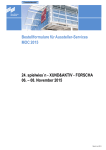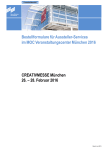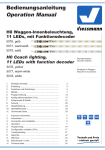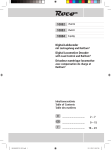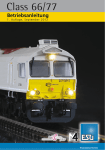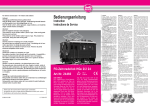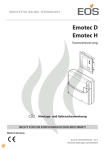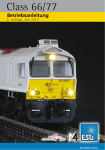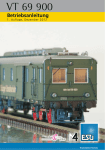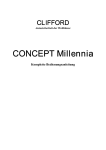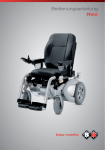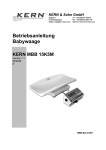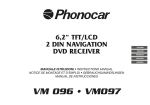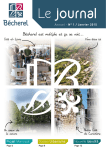Download Digital Waggon.indd
Transcript
41273 41274 41275 41276 Multifunktionszug Multifunction Train Train multifonctions Bedienunsanleitung Instruction Manual Manuel d’utilisation Digital Waggon.indd 1 D ................................ 2 − 21 GB ................................ 22 − 41 F ................................ 42 − 61 23.10.2008 08:31:52 Zeichenerklärung D Gilt für Lok und Wagen Gilt nur für Lok Gilt nur für Wagen Warnung Hinweis/Tipp Wichtig für Motorola2) Anwender 1) „Märklin“ ist ein eingetragenes Warenzeichen der Geb. Märklin & Cie. GmbH, Göppingen 2) „Motorola“ ist ein eingetragenes Warenzeichen der Motorola Inc., TempePhoenix (Arizona/USA) 2 2 Digital Waggon.indd 2 23.10.2008 08:31:54 INHALTSVERZEICHNIS D Aufstellung und Funktionsübersicht....................................................................................................... 4 Funktionen im Digitalbetrieb Bahnhofsbetrieb - Ein möglicher Ablauf ............................................................................................... Raum für Individualisierung................................................................................................................... Funktionstastenbelegung (Set Auslieferungszustand) ........................................................................... 5 5 6 Lokeinstellungen Allgemeines............................................................................................................................................ 7 Hinweise zur Verknüpfung von Fahren − Geräusch................................................................................ 7 CV Liste Lok ........................................................................................................................................... 7 – 8 Wageneinstellungen Adresse................................................................................................................................................... 9 Konfiguration (CV29) ............................................................................................................................. 9 Wageneinstellungen (CV62) .................................................................................................................. 9 Wagen Konfiguration über CV62 (Schaffnerwagen) .............................................................................. 9 Auf Werkszustand rücksetzen ................................................................................................................ 9 CV Liste Wagen ..................................................................................................................................... 10 – 11 CV-Kombinationen Kombinationen für CV29 und CV49 ....................................................................................................... 12 Betrieb mit DCC-Zentrale (multiMAUS) Programmierarten ................................................................................................................................. Auslesen ................................................................................................................................................ Funktionstastengruppierung für Betrieb auf eigener Adresse ................................................................ 13 13 13 Betrieb mit Märklin1)6021 Mehr Funktionen ................................................................................................................................... Programmiermodus................................................................................................................................ 14 14 Betrieb mit Märklin1) Mobile Station Inbetriebnahme (Lok) ............................................................................................................................ Inbetriebnahme (Wagen) ....................................................................................................................... Funktionstasten Märklin1) Mobile Station (Lok) .......................................................................................... Funktionstasten Märklin1) Mobile Station (Wagen)...................................................................................... Programmieren mit Märklin1) Mobile Station .............................................................................................. 16 17 18 18 18 Analogbetrieb Funktionen im Analogbetrieb ................................................................................................................ 19 Anhang Functionmapping (laut NMRA Norm)..................................................................................................... Functionmapping-Tabelle ...................................................................................................................... Warnungen und Hinweise...................................................................................................................... Fehlertabelle Wagen............................................................................................................................... 19 20 21 21 3 3 Digital Waggon.indd 3 23.10.2008 08:31:54 Digital Waggon.indd 4 LOK Sound F1 Elektrisch bewegliche Stromabnehmer F2,F12 Führerstandlicht F5 Stirnlicht (Licht Taste, F0) mit separat schaltbarer Schlussbeleuchtung F8 LOK Pfiff F6, F9 Bahnhofsansage F14 1./2. Klasse 2.Klasse Schlussbeleuchtung Licht-Taste (F0) 2.Klasse beidseitig elektrisch bewegliche Wagentüren F3, F4 Wageninnenbeleuchtung (flackerfrei!) F7 1.Klasse, 1./2. Klasse und 2. Klasse mit LokSound/Funktionsdecoder 1.Klasse Schaffnerwagen F16, F17 Aufstellung und Funktionsübersicht: D 4 4 23.10.2008 08:31:58 D Funktionen im Digitalbetrieb Das Set (Lok und Wagen) ist im Auslieferungszustand über Adresse 3 bedienbar. Der Funktionszug besitzt 19 Funktionen. Die Funktionstasten wurden so definiert, dass auch Benutzer mit weniger Funktionstasten die Hauptfunktionen (Pantographen, Türen, Sounds, Lichter) einfach erreichen können. Durch die 20 Funktionstasten der multiMAUS ist die Bedienung mit ihr besonders komfortabel. Bitte beachten Sie als Märklin1) 6021- oder Mobile Station- Benutzer die Kapitel „Betrieb mit Märklin1) 6021“ bzw. „Betrieb mit Märklin1) Mobile Station“. Bahnhofsbetrieb – Ein möglicher Ablauf: Der Lokführer steigt in den Führerstand 1 ein und schaltet zuerst das Führerstandslicht ein. (F5) Jetzt löst er das Heben eines Pantographen aus, im normalen Fahrbetrieb den hinteren. (F2) Er schaltet den Hauptschalter ein, der Kompressor beginnt kurz zu laufen. (F1, F10) Wenn der Zug im Bahnhof steht, können jetzt die Passagiere auf der Bahnsteigseite einsteigen. Die Innenbeleuchtung wird in den drei Wagen eingeschaltet. (F3 o. F4) (F7) Es ertönt die Bahnhofsdurchsage oder die Schaffneransage. (F14 o. F17) Nachdem alle Fahrgäste eingestiegen sind und die Türen geschlossen sind, steigt der Schaffner (F3 o. F4) mit einem Abfahrtspfiff ein und schließt die letzte Tür. Zur Abfahrt bereit, schaltet der Lokführer die Außenbeleuchtung ein und das, nicht mehr benötigte, Führerstandslicht aus. (F0 u. F5) Mit einem kurzen Pfiff setzt der Lokführer den Zug feinfühlig in Bewegung . (F6, Regler) Auf offener Strecke wird hochbeschleunigt und wegen Annäherung an einen Bahnübergang ein langer Pfiff ausgegeben. (Regler, F9) Raum für Individualisierung Natürlich können die Lok und die Wagen unabhängig voneinander auf verschiedenen Adressen betrieben werden. Dazu enthalten die Lok und jeder Wagen einen völlig autarken Multiprotokoll-Decoder. Zum einfachen Bedienen bei eigener Adresse gibt es für Lok und Wagen auswählbare, leicht einstellbare Funktionstastengruppierungen. Mit dem „Functionmapping“ können Sie sich zusätzlich die Funktionstasten beliebig mit Funktionen belegen. Beim Durchlesen dieser Bedienungsanleitung und beim ersten Ausprobieren werden Sie sehen, dass mit dieser Garnitur das Modell wieder einen großen Schritt an das Original heran rückt. Nehmen Sie beim Programmieren der Lok die Wagen vom Gleis, weil diese sonst mitprogrammiert werden. Nehmen Sie beim Programmieren der Wagen die Lok vom Gleis, weil diese sonst mitprogrammiert wird. 5 5 Digital Waggon.indd 5 23.10.2008 08:31:58 Funktionstastenbelegung (Set-Auslieferungszustand) D Die Funktionstasten wurden so belegt, dass das Set (Lok und 3 Wagen) über eine Lok-Adresse (im Auslieferungszustand Adresse 3) bedient werden können. F-Taste Funktion Art der Funktion Richtungs- Zusatzabhängig geräusch LOK EIN/AUS F01 Loksound EIN/AUS F02 Stromabnehmer Führerstand 2 (hinten) HEBEN/SENKEN F05 Führerstandslicht Führerstand 1 (vorne) EIN/AUS F06 Pfiff kurz EIN F08 Schlusslicht Lok EIN/AUS F09 Pfiff lang EIN/AUS F10 Kompressor EIN/AUS F12 Stromabnehmer Fst. 1 (vorne) HEBEN/SENKEN F13 Rangiergang EIN/AUS F14 Bahnhofsdurchsage EIN F15 Führerstandslicht Fst. 2 (hinten) EIN/AUS Licht Schlusslicht Wagen EIN/AUS F03* Wagentüren Gangseite ÖFFNEN/SCHLIESSEN F04* Wagentüren Abteilseite ÖFFNEN/SCHLIESSEN F07 Wageninnenbeleuchtung LED - flackerfrei EIN/AUS Motorola 2) 2.Adresse Stirnlicht Lok Motorola 2) 1.Adresse Licht WAGEN F17** Schaffneransage „Alles einsteigen bitte!“ F18 Schlusslichtsperre Wagen EIN: Schlusslicht leuchtet NIE AUS: Steuerung über F0 Mot. 2.Adr. Schaffnerpfiff Motorola 2) 1.Adresse F16** EIN/AUS *) Die Türen eines Wagens lassen aus mechanischen Gründen gleichzeitig nur auf einer Längsseite („Gang“ oder „Abteil“) die Stellung „offen“ zu! **) Im Auslieferungszustand ist der 2. Klasse Wagen der Schaffnerwagen. Jeder Wagen kann bei Bedarf als Schaffnerwagen über CV62 eingestellt werden. 6 6 Digital Waggon.indd 6 23.10.2008 08:31:59 D Lokeinstellungen Allgemeines Der in dieser Lok enthaltene LokSound- Decoder wurde optimal auf die Lok eingestellt. Dennoch können Sie viele Decoder-Eigenschaften Ihren Wünschen anpassen. Dazu lassen sich bestimmte Parameter (die so genannten CVs – Configuration Variable – oder Register) verändern. Prüfen Sie aber vor jeder Programmierung, ob diese tatsächlich notwendig ist. Falsche Einstellungen können dazu führen, dass der Decoder nicht richtig reagiert. Für einen hohen Fahrkomfort ist der Decoder werkseitig auf 28 Fahrstufen vorprogrammiert. Damit ist er mit allen modernen DCC- (multiMAUS) und Motorola2)-Steuergeräten einsetzbar. Der LokSound-Decoder wurde speziell für die zusätzlichen Funktionen verändert und darf nicht gegen einen im Handel erhältlichen Decoder ausgetauscht werden. Dies kann zu einem Defekt der Pantographenantriebe führen! Soll die Lok umprogrammiert werden, darf nur die Lok auf dem Programmiergleis stehen. Der übrige Zug ist unbedingt abzutrennen, da sonst eventuell eine Programmierung nicht ausgeführt werden kann oder die Wagen mitprogrammiert werden. Hinweise zur Verknüpfung von Fahren − Geräusch Bei diesem Sound-Decoder der neuesten Generation ist eine stärkere Verknüpfung von Fahr- und SoundAbläufen vorhanden: So setzt sich die Lok bei eingeschaltetem Sound (Funktionstaste «F1» aktiviert) vorbildentsprechend erst dann in Bewegung, wenn die Sound-Sequenz «Motorstart» vollständig abgeschlossen und der Zustand «Motorleerlauf» erreicht ist. Umgekehrt wird die Sound-Sequenz «Motor aus» nur dann nach erneuter Betätigung der Funktionstaste «F1» (jetzt «Sound aus») ablaufen und anschließend in den Zustand «Motorleerlauf» übergehen, wenn die Lok beim Betätigen der Taste «F1» bereits zum Stehen gekommen ist. Ein schnelles Ein- oder Ausschalten des Sounds über die Taste «F1» ist somit nur dann möglich, wenn die Lok schon bzw. noch in Bewegung ist. CV-Liste Lok CV Name Einstellbare Werte Default Werte 1 Adresse (= kurze Adresse) 01 – 99 03 2 Anfahrspannung (kleinste Kriechgeschwindigkeit) 01 – 75 03 3 Beschleunigungszeit (vom Stillstand bis Maximalgeschwindigkeit) 00 – 64 14 4 Bremszeit (von Maximalgeschwindigkeit bis Stillstand) 00 – 64 07 5 Maximalgeschwindigkeit 00 – 64 38 6 Mittengeschwindigkeit (bei mittlerer Fahrstufe) 00 – 64 22 8 Reset-Funktion Zurücksetzen aller Werte auf Werkseinstellung; (An lesefähigen Verstärkern/Zentralen ist die Herstellererkennung lesbar) 00 – 64 08=Reset 7 7 Digital Waggon.indd 7 23.10.2008 08:31:59 D 13 Analogmodus F1-F8 17 + 18 Lange Adresse (Vorraussetzung: In CV29 ist die lange Adresse eingeschalten) 29 Einstellungen 1 Bit 0: Richtungsumkehr Bit 1: Fahrstufen (DCC) Bit 2: Analogbetrieb Bit 5: Lange Adresse Siehe Tabelle im Kapitel „CV-Kombinationen“ Einstellungen 2 Bit 0: Lastregelung aktiv Bit 1: 30 kHz Motortaktfreqenz Bit 2: Licht bei Märklin1) - Delta - Betrieb Bit 3: Automatische DCC Fahrstufenerkennung Siehe Tabelle im Kapitel „CV-Kombinationen“ Analog-Modus 00 = beide aus 01 = AC-Modus ein 02 = DC-Modus ein 03 = beide ein 49 50 51 Brems-Modus-Erkennung Bit 0: Märklin1) 72441 Bit 1: Zimo aktuell Bit 3: Lenz DC 63 Gesamtlautstärke aller Geräusche (CV 121 -123-Einstellungen beachten!) 65 Functionmapping Ändert die Funktionstastenbelegung, um auch mit weniger Funktionstasten die wichtigsten Funktionen ansprechen zu können. 00 – 255 128 192 ---------------------00 06 27 Wert: 1 Wert: 2 Wert: 8 03 07 00 – 64 55 1: Set (default) 2: Betrieb mit Märklin1) 6021 3: Betrieb mit Märklin1) Mobile Station Set 113 Lichtdimmung vorne (15=maximale Helligkeit) 00 – 15 15 114 Lichtdimmung hinten (15=maximale Helligkeit) 00 – 15 15 119 Pantograph Führerstand 1 Ändert die Höhe von Pantograph 1 00 – 20 individuell eingestellt 120 Pantograph Führerstand 2 Ändert die Höhe von Pantograph 2 00 – 20 individuell eingestellt 121 Lautstärkeregler für Pantographen (max. Lautstärke nur, wenn auch CV63=Wert 64) 00 – 64 64 122 Lautstärkeregler für Schaltgeräusch (max. Lautstärke nur, wenn auch CV63=Wert 64) 00 – 64 64 123 Lautstärkeregler für Fahrgeräusche und restliche Zusatzgeräusche (max. Lautstärke nur, wenn auch CV63=Wert 64) 00 – 64 64 8 8 Digital Waggon.indd 8 23.10.2008 08:31:59 D Wageneinstellungen Wollen Sie andere Decoder (z.B. in Lok, Wagen usw.) programmieren, müssen Sie den Drehtürwagen vom Gleis nehmen, da dieser sonst mitprogrammiert wird. Adresse Im Auslieferungszustand ist der Wagen auf Adresse 3 programmiert. Der Wagen kann über die CV1 auf verschiedene Adressen von 1-99 programmiert werden. Über die lange Adressierung (CV17/18) sind 9999 Adressen möglich (dabei muss zusätzlich CV29 Bit5 aktiviert werden, siehe CV-Liste). Die Schlussbeleuchtung des Wagens ist logisch nur an die Lok gekoppelt (Fahrtrichtung, Aktivierung), wenn die Adressen beider gleich sind. Konfiguration (CV29) Über CV29 können Sie Decoderkonfigurationen vornehmen. In der CV-Liste hat jede Konfiguration einen Wert. Die gewollten Einstellungen (Werte) müssen addiert und CV29 damit programmiert werden. Bit 0 (Wert 1 oder 0) tauscht die Richtung, wenn der Wagen verdreht an die Lok angehängt wird. Damit stimmt die Schlussbeleuchtung wieder mit der Richtung überein. Bit 1 (Wert 2 oder 0) enthält die Fahrstufenanzahl. Diese ist wichtig für ein korrektes, richtungsabhängiges Leuchten der Schlussbeleuchtung und muss mit der Fahrstufeneinstellung/-bedienung der multiMAUS/ Zentrale übereinstimmen. Ein Blinken der Schlussbeleuchtung bei Drehen des Fahrtreglers ist ein Indiz für eine falsche Fahrstufeneinstellung. Bit 2 (Wert 4 oder 0) schaltet den Analogbetrieb ein oder aus. Bit 5 (Wert 32 oder 0) schaltet den „Lange Adresse“-Modus ein oder aus. Die Kombinationen der Einstellungsmöglichkeiten befinden sich im Kapitel „CV-Kombinationen“. Wageneinstellungen (CV62) Weitere Wageneinstellungen betreffend dem Schaffner und der Türbewegung können Sie über CV62 vornehmen. Im Werkszustand ist der 2. Klasse Wagen als Schaffnerwagen definiert, d.h. Schaffneransage und Pfiff kommen aus diesem Wagen (Der Pfiff ist automatisch eingestellt). Wagen Konfiguration über CV62 (Schaffnerwagen) CV62 Wagen Art Werkswert 1. Klasse ohne Pfiff und Ansage 0 1./2. Klasse ohne Pfiff und Ansage 0 2. Klasse mit Schlusslicht mit Pfiff und Ansage 3 Wollen Sie zum Beispiel den 1.Klasse als Schaffnerwagen (d.h. mit Pfiff und Ansage), so programmieren Sie auf CV62 den Wert „3“. Auf Werkszustand rücksetzen Die CV-Einstellungen des Wagens werden in den Werkszustand zurückgesetzt indem Sie den Wert 8 auf CV8 programmieren. Die Tür-Mechanik des Wagens begibt sich in den Ausgangszustand indem Sie den Wert 7 auf CV7 programmieren. 9 9 Digital Waggon.indd 9 23.10.2008 08:32:00 D CV Liste Wagen CV Name Beschreibung 1 Wagenadresse Der Decoder reagiert auf den Adressbereich 1-127. Die multiMAUS, wie auch andere Zentralen, spricht 1-99 über die kurze Adresse an, den Rest über die lange Adresse (CV17/18). 7 Versionsnummer Interne Software-Version des Decoders Das Beschreiben mit dem Wert 7 bewirkt das Rücksetzen der Türen in den Auslieferungszustand. 8 Herstellerkennung Hersteller-ID der Modelleisenbahn GmbH Das Beschreiben mit dem Wert 8 bewirkt das Rücksetzen der CV’s in den Auslieferungszustand. 13 Analog F1-F8 Funktionstasten im Analog Modus F7: In 14 Analog Licht, F9-F14 Funktionstasten im Analog Modus F0: S 17 Lange Adresse 18 höherwertiges Byte (hByte) niederwertiges Byte (nByte) Berechnung: Lange Adresse = (hByte-192)*256 + nByte Bsp.: Adr 170: hByte = 192, nByte = 170 Adr 270: hByte = 193, nByte = 14 Adr 370: hByte = 193, nByte = 114 29 Konfiguration Sie e „LAN A Bit 0: Richtungsumkehr 0: no Bit 1: Fahrstufen (DCC) 0: 14 siehe Tabelle im Kapitel Bit 2: Analogbetrieb 0: AU „CV-Kombinationen“ Bit 5: Lange Adresse 0: W 32: L 33 - 54 Function Mapping Mit CVs kann man jeder Funktionstaste Funktionen zuordnen. (siehe im Anhang„Function Mapping“) 56 Erweiterte Konfiguration Bit 0: Funktionstasten speichern 0: au Bit 3: Märklin 2. Adresse 0: au 1) 61 Funktionstastengruppierung beschreibt automatisch CV33-54 Wert 0: Standardbelegung für Set mit Lok auf gleicher Adresse Wert 1: Für DCC-Betrieb auf eigener Adresse Wert 2: Für Märklin1) 6021-Betrieb auf eigener Adresse Wert 3: Für Märklin1) Mobile Station-Betrieb auf Doppeladresse (Lokdatenbank 37540) 62 Wagen Konfiguration Bit 0: Manueller Schaffner 0: AU Bit 1: Automatischer Schaffnerpfiff 0: AU Bit 2: Automatische Schaffneransage 0: AU Bit 3: Schnelles Schließen --> kürzere Zeit-Abstände beim Schließen der Türen: Es wird nicht auf die Schaffneransage aus einem anderen Wagen gewartet. Ist der Wagen selbst ein Schaffnerwagen, so hat das schnelle Schließen keinen Einfluss. 0: AU 63 Dimmung der Innenbeleuchtung Die Helligkeit der Innenbeleuchtung kann über diese CV eingestellt werden. 10 10 Digital Waggon.indd 10 23.10.2008 08:32:00 D Wert/Erläuterung Bereich Default Wert 1-99/ 1-127 3 161 F7: Innenbeleuchtung AUS (0) / EIN (64) 0/64 0 F0: Schlussbeleuchtung AUS (0) / EIN (1) 0/1 0 100-9999 192 0 Sie ersparen sich die Berechnung von CV17/18 wenn Sie die „LANGE ADRESSE“-Programmierung der multiMAUSverwenden. Aktivierung der langen Adresse über CV29. 0: normal, 1: vertauscht 0/1 AUS: 0 0: 14 Fahrstufen, 2: 28/128 Fahrstufen 0/2 EIN: 2 0: AUS, 4: Funktionen werden, wie in CV13/14 eingestellt, geschalten 0/4 AUS: 0 0: Wagenadresse (CV1) verwenden, 32: Lange Adresse (CV17/18) verwenden 0/32 AUS: 0 0: ausgeschaltet, 1: eingeschaltet 0/1 9 0: ausgeschaltet, 8: eingeschaltet 0/8 0-3 0 nbank 37540) 0: AUS, 1: EIN --> reagiert auf F16,F17 0/1 0: AUS, 2: EIN --> automatischer Schaffnerpfiff beim Schließen der Türen 0/2 0: AUS, 4: EIN --> automatischer Schaffneransage bei Türenbewegung 0/4 0: AUS, 8: EIN --> kürzere Zeitabstände beim Schließen der Türen: 0/8 1. Klasse: 0 1./2.Klasse: 0 2. Klasse: 3 wartet. den. 0-15 12 11 11 Digital Waggon.indd 11 23.10.2008 08:32:00 D CV-Kombinationen Kombinationen für CV29 und CV49 CV29 Bit 0 Fahrtrichtung CV49 Bit 1 Fahrstufen Bit 5 Bit 2 Betriebsart Wert Wert kurze Adresse lange Adresse normal 14 digital 0 32 vertauscht 14 digital 1 33 normal 28/128 digital 2 (default) 34 vertauscht 28/128 digital 3 35 normal 14 analog+digital 4 36 vertauscht 14 analog+digital 5 37 normal 28/128 analog+digital 6 38 vertauscht 28/128 analog+digital 7 39 Bit 0 Lastregelung Bit 1 Motortaktfrequenz Bit 4 Bit 3 Märklin 2. Adresse 1) Wert Wert keine Automatische Fahrstufenerkennung Automatische Fahrstufenerkennung inaktiv 15kHz aus 0 16 aktiv 15kHz aus 1 17 inaktiv 30kHz aus 2 18 aktiv 30kHz aus 3 19 inaktiv 15kHz ein 8 24 aktiv 15kHz ein 9 25 inaktiv 30kHz ein 10 26 aktiv 30kHz ein 11 27 (default) 12 12 Digital Waggon.indd 12 23.10.2008 08:32:01 D Betrieb mit DCC-Zentrale (multiMAUS) Da die multiMAUS über 20 Funktionstasten und Lichttaste verfügt ist die Bedienung des gesamten Sets mit ihr besonders komfortabel. Programmierarten: Lok und Wagen reagieren auf alle DCC-Programmierarten. Wir empfehlen: Direkt CV-Programmierung (byteweise) oder POM-Modus (Programmierung am Hauptgleis). Das Programmieren ist im Handbuch der multiMAUSbeschrieben. Auslesen: Mit einer entsprechenden Ausrüstung (z.B. Rocomotion 10785) können Sie die Werte byte- und bitweise auslesen. Funktionstastengruppierung für Betrieb auf eigener Adresse Wenn Sie den/die Wagen alleine, d.h. auf einer anderen Adresse wie die Lok, bedienen wollen, können Sie hiermit die im Set aufgeteilten Funktionen einfach zu einem Block zusammenfassen. Programmieren Sie dazu auf CV61 den Wert 1. Für Experten gibt es die Möglichkeit die Funktionen einzeln zu „mappen“ (siehe Anhang). Funktionstaste *) Funktion Art der Funktion F00 Wagenschlusslicht EIN/AUS F01 Wagentüren Gangseite ÖFFNEN/SCHLIESSEN F02 Wagentüren Abteilseite ÖFFNEN/SCHLIESSEN F03 Wageninnenbeleuchtung EIN/AUS F04* Schaffnerpfiff EIN F05* Schaffneransage „Alles einsteigen bitte“! EIN/AUS Richtungsabhängig Zusatzgeräusch Im Auslieferungszustand ist der 2. Klasse Wagen der Schaffnerwagen. Jeder Wagen kann bei Bedarf als Schaffnerwagen über CV62 eingestellt werden. 13 13 Digital Waggon.indd 13 23.10.2008 08:32:02 D Betrieb mit Märklin1) 6021 Mehr Funktionen Sie haben beim ersten Probieren sicherlich bemerkt, dass im Auslieferungszustand nicht alle Funktionen wie in der „Funktionsübersicht“ beschrieben erreichbar sind. Um mehr Funktionen mit der Märklin1) 6021 ansprechen zu können gibt es für Sie zum einen: Die „2. Adresse“. Diese ist im Auslieferungszustand aktiviert und um eins höher als die reguläre Adresse. Beispiel 1 Adresse (CV1) = 3 (Auslieferungszustand) 2. Adresse = 4 zum anderen: Um mehr Funktionen auf unterschiedlichen Adressen (1. Adresse + 2. Adresse) ansprechen zu können gibt es eine eigene Funktionstastenbelegung (siehe Tabelle auf der nächsten Seite), die über CV65 (Lok) bzw. CV61 (Wagen) aktivierbar ist. Beispiel 2 Lok: Adresse 3 (CV1) und 4 Wagen: Adresse 5 (CV1) und 6 Programmiermodus Hinweis: Der DIP-Schalter #2 an der Hinterseite der Märklin1) 6021 muss zum Programmieren eingeschalten sein. Programmieren: 1. Fahrtregler auf ‚0‘ stellen 2. stop + go ca. 1sec. drücken um Reset auszulösen (alternativ die Station Aus/Einstecken) 3. stop drücken 4. Adresse oder ‚80‘ eingeben 5. Während dem Betätigen der Fahrtrichtungsumkehr go drücken 6. CV bei Märklin1) 6021 zweistellig wie eine Lokadresse eingeben (CV1-79 möglich) 7. Fahrtrichtungsumkehr betätigen 8. Wert zweistellig eingeben (1-79 möglich, für den Wert 0: ‚80‘ eingeben) 9. Fahrtrichtungsumkehr betätigen 10. Der Decoder wurde programmiert und befindet sich im Fahrmodus 14 14 Digital Waggon.indd 14 23.10.2008 08:32:02 D Stellen Sie nur die Lok auf das Gleis! Programmieren Sie auf CV65 den Wert 2 (siehe Programmiermodus). Funktions Taste Funktion Art Richtungs- Zusatzder Funktion abhängig geräusch 1. Adresse function Stirnlicht Lok EIN/AUS 1. Adresse f1 Loksound EIN/AUS 1. Adresse f2 Stromabnehmer Führerstand 2 (hinten) HEBEN/SENKEN 1. Adresse f3 Führestandslicht Führerstand 1 (vorne) EIN/AUS 1. Adresse f4 Schlusslicht Lok EIN/AUS 2. Adresse f1 Pfiff kurz EIN 2. Adresse f2 Stromabnehmer Fst. 1 (vorne) HEBEN/SENKEN 2. Adresse f3 Führerstandslicht Fst. 2 (hinten) EIN/AUS 2. Adresse f4 Bahnhofsdurchsage EIN Stellen Sie nur die Wagen auf das Gleis! Programmieren Sie auf CV61 den Wert 2 (siehe Programmiermodus). Ändern Sie die Adresse (wie in Beispiel 2) Funktions Taste Funktion Art der Funktion 1. Adresse function Wagenschlusslicht & Innenbeleuchtung EIN/AUS 1. Adresse f1 Wagentüren Gangseite ÖFFNEN/SCHLIESSEN 1. Adresse f2 Wagentüren Abteilseite ÖFFNEN/SCHLIESSEN 1. Adresse f3* Schaffnerpfiff EIN/AUS 1. Adresse f4* Schaffneransage „Alles einsteigen bitte“! EIN/AUS 2. Adresse keine Funktionen belegt *) Richtungs- Zusatzabhängig geräusch Im Auslieferungszustand ist der 2. Klasse Wagen der Schaffnerwagen. Jeder Wagen kann bei Bedarf als Schaffnerwagen über CV62 eingestellt werden. 15 15 Digital Waggon.indd 15 23.10.2008 08:32:02 D Betrieb mit Märklin1) Mobile Station Inbetriebnahme: Stellen Sie die Lok ohne Wagen auf das Gleis! 1. Anlegen der Lok: „ESC“ drücken „NEUE LOK“ --> OK drücken „Datenbank“ --> OK drücken --> bis zu Lok 37540 drehen --> OK drücken ‚BR55‘ Sie haben jetzt erfolgreich die Lok angelegt, jedoch liegt diese noch auf einer anderen Adresse. Um die Adresse zu ändern gehen Sie wie folgt vor: 2. Einstellen der Adresse ESC drücken Nach Rechts drehen „LOK ÄNDERN“ --> OK drücken „Adresse“ --> OK drücken Drehen z.B.: bis zu Adresse „3/4“ --> OK drücken „PROG LOK?“ --> OK drücken (Lichter blinken) Sie haben jetzt erfolgreich die Adresse eingestellt und können mit der Lok fahren. Um die Funktionen wie in der Tabelle auf der nächsten Seite ansprechen zu können, gehen Sie wie folgt vor: 3. Einstellen der Funktionstasten: „ESC“ drücken Nach Rechts drehen „LOK ÄNDERN“ --> OK drücken 2x nach Links drehen „REG“ --> OK drücken Drehen bis REG „65“ blinkt --> OK drücken Drehen bis REG 65: „3“ blinkt --> OK drücken (Lichter blinken) Die Lok wird jetzt mit der passenden Funktionstastenbelegung programmiert. Sie können jetzt die Funktionen laut Tabelle schalten. Um den Namen zu ändern gehen Sie wie folgt vor: 4. Ändern des Namens: „ESC“ drücken Nach Rechts drehen „LOK ÄNDERN“ --> OK drücken Nach Rechts drehen „NAME“ --> OK drücken Buchstaben mit Drehregler ändern Weiter durch Drücken des Drehknopfes Zurück durch drücken von „ESC“ Fertig mit OK 16 16 Digital Waggon.indd 16 23.10.2008 08:32:03 D Stellen Sie die 3 Wagen ohne Lok auf das Gleis! 1. Anlegen des Wagen (gleich wie Anlegen einer neuen Lok): „ESC“ drücken „NEUE LOK“ --> OK drücken „Datenbank“ --> OK drücken --> bis zu Lok 37540 ‚BR55‘ drehen --> OK drücken Sie haben jetzt erfolgreich die Wagen angelegt, jedoch liegen diese noch auf einer anderen Adresse. Um die Adresse zu ändern, gehen Sie wie folgt vor: 2. Einstellen der Adresse (auf andere Adresse wie Lok um alle Funktionen bedienen zu können): „ESC“ drücken Nach Rechts drehen „LOK ÄNDERN“ --> OK drücken „Adresse“ --> OK drücken Drehen z.B.: bis zu Adresse „5/6“ --> OK drücken „PROG LOK?“ --> OK drücken Die Wagen werden jetzt auf der neuen Adresse programmiert (Es ertönt 3mal ein Pieps-Ton). 3. Einstellen der Funktionstasten: „ESC“ drücken Nach Rechts drehen „LOK ÄNDERN“ --> OK drücken 2x nach Links drehen „REG“ --> OK drücken Drehen bis REG „61“ blinkt --> OK drücken Drehen bis REG 61: „3“ blinkt --> OK drücken Die Wagen werden jetzt mit der passenden Funktionstastenbelegung programmiert (Es ertönt 3mal ein Pieps-Ton). 4. Ändern des Namens: „ESC“ drücken Nach Rechts drehen „LOK ÄNDERN“ --> OK drücken Nach Rechts drehen „NAME“ --> OK drücken Buchstaben mit Drehregler ändern Weiter durch Drücken des Drehknopfes Zurück durch drücken von „ESC“ Fertig mit OK 17 17 Digital Waggon.indd 17 23.10.2008 08:32:03 D Funktionstasten Märklin1) Mobile Station (Lok) Funktions Taste Funktion Art der Funktion Richtungsabhängig Zusatzgeräusch Stirnlicht Lok EIN/AUS Loksound EIN/AUS Stromabnehmer Führerstand 2 (hinten) HEBEN/SENKEN Führestandslicht Führerstand 1 (vorne) EIN/AUS Schlusslicht Lok EIN/AUS Pfiff kurz EIN Stromabnehmer Fst. 1 (vorne) HEBEN/SENKEN Führerstandslicht Fst. 2 (hinten) EIN/AUS Bahnhofsdurchsage EIN Funktionstasten Märklin1) Mobile Station (Wagen) Funktions Funktion Taste Art der Funktion Wagenschlusslicht EIN/AUS Wagentüren Gangseite ÖFFNEN/SCHLIESSEN Wagentüren Abteilseite ÖFFNEN/SCHLIESSEN Schaffnerpfiff EIN/AUS Richtungsabhängig Schaffneransage EIN/AUS „Alles einsteigen bitte“! Innenbeleuchtung EIN/AUS Zusatzgeräusch Programmieren mit Märklin1) Mobile Station 1. „ESC“-Taste drücken 2. Nach Rechts drehen „LOK ÄNDERN“ --> OK drücken 3. 2x nach Links drehen „REG“ --> OK drücken 4. Drehen bis der gewünschte CV blinkt --> OK drücken 5. Drehen bis der gewünschte Wert blinkt --> OK drücken Die Lok bestätigt das Programmieren mit kurzem Blinken. Der Wagen bestätigt das Programmieren mit Blinken der Innenbeleuchtung und zusätzlichen Tönen. 18 18 Digital Waggon.indd 18 23.10.2008 08:32:06 D Analogbetrieb Funktionen im Analogbetrieb Über CV13/14 können die Schlussbeleuchtung und die Innenbeleuchtung immer aktiv oder abgeschaltet werden. Im Analogbetrieb sind keine Funktionen schaltbar. Der Analogbetrieb wird über CV29 eingeschaltet. Die Schlussbeleuchtung ist im Analogmodus DC richtungsabhängig. Wird der Wagen gezogen, so leuchtet die Schlussbeleuchtung, wird er geschoben, so erlischt die Schlussbeleuchtung. Da bei langsamer Geschwindigkeit eine zu niedrige Spannung am Gleis anliegt, funktioniert der Analogbetrieb nur eingeschränkt (ab ~7V). Wir empfehlen, bei Verwendung von Bremsstrecken den Analogbetrieb auszuschalten (CV29). Anhang Functionmapping (laut NMRA Norm) Mit dem Functionmapping können Sie eine oder mehrere Funktionen einer Funktionstaste zuordnen. Vorgehensweise: Programmieren Sie auf die CV neben der gewünschten Funktionstaste den Wert der in dieser Zeile bei der Funktion steht (siehe Tabelle nächste Seite). Sie können pro Funktionstaste mehrere Funktionen kombinieren, indem Sie deren Werte addieren. Der graue Bereich ist aufgrund der Norm nicht möglich. Achten Sie darauf, nicht beide Türen (Gang/Abteil) auf eine Funktion zu legen, da − mechanisch bedingt − nur eine Seite geöffnet werden kann. Beispiele: Sie wollen die Schlussbeleuchtung und die Wageninnenbeleuchtung mit der Lichttaste (F0) gleichzeitig schalten: In der Zeile von CV33 hat die Schlussbeleuchtung den Wert 1, die Wageninnenbeleuchtung den Wert 32. --> Programmieren Sie auf CV33 den Wert 33 (1+32). Sie wollen die Tür-Gangseite mit F8 und die Tür-Abteilseite mit F9 schalten: In der Zeile von F8 hat die Tür-Gangseite den Wert 8. In der Zeile von F9 hat die Tür-Abteilseite den Wert 2. Sie wollen die Türpaare der 3 Wagen einzeln öffnen (Klasse 1: F11 & F12, Klasse 2: F13 & F14, Klasse 3: F15 & F16), aber alle 3 Wagen über eine Adresse ansprechen: Die Wagen müssen dazu einzeln programmiert werden: 1. Klasse: 1./2. Klasse: 2. Klasse: In der Zeile von F11 (CV45) hat die Tür-Gangseite den Wert 1. In der Zeile von F12 (CV46) hat die Tür-Abteilseite den Wert 2. In der Zeile von F13 (CV47) hat die Tür-Gangseite den Wert 64. In der Zeile von F14 (CV48) hat die Tür-Abteilseite den Wert 128. In der Zeile von F15 (CV49) hat die Tür-Gangseite den Wert 64. In der Zeile von F16 (CV50) hat die Tür-Abteilseite den Wert 128. Den Schaffnerpfiff der vorher auf F16 war legen Sie auf F19: CV53 --> 8 19 19 Digital Waggon.indd 19 23.10.2008 08:32:07 Functionmapping-Tabelle Funktionstaste Tür Gangseite Wageninnenbeleuchtung Schaffneransage Schaffnerpfiff Schlusslichtsperre Schlusslichtbeleuchtung Funktion CV Tür Abteilseite D 33 F0 Licht vorwärts 128 64 32 16 8 n.b. 2 1* 34 F0 Licht rückwärts n.b. n.b. n.b. n.b. n.b. n.b. 2 n.b. 35 F1 128 64 32 16 8 n.b. 2 1 36 F2 128 64 32 16 8 n.b. 2 1 37 F3 128 64* 32 16 8 n.b. 2 1 38 F4 16* 8 4 2 1 39 F5 16 8 4 2 1 40 F6 16 8 4 2 1 41 F7 16 8 4* 2 1 42 F8 2 8 4 2 1 43 F9 2 1 44 F10 2 1 45 F11 2 1 46 F12 47 F13 128 64 32 16 8 n.b. 2 1 48 F14 128 64 32 16 8 n.b. 2 1 49 F15 128 64 32 16 8 n.b. 2 1 50 F16 128 64 32 16 8* n.b. 2 1 51 F17 128 64 32 16* 8 n.b. 2 1 52 F18 128 64 32 16 8 n.b. 2* 1 53 F19 128 64 32 16 8 n.b. 2 1 54 F20 128 64 32 16 8 n.b. 2 1 1 *Default n.b. : nicht benützt 20 20 Digital Waggon.indd 20 23.10.2008 08:32:07 Warnungen und Hinweise D Die Türen müssen aktiv durch den Bediener über den voreingestellten Befehl F03 oder F04 geschlossen werden. Sie schließen nicht automatisch bei Anfahren des Zuges! Für Schäden, die daraus entstehen, wenn mit noch geöffneten Türen gefahren wird, kann keine Gewähr übernommen werden (Gefahrpunkte sind Zugbegegnungen in Kurven, Tunnelportale, Oberleitungsmaste etc.!). Die Ausladung eines Wagens mit geöffneter Tür auf der Geraden beträgt 25mm von der Gleismitte aus (zulässiges Lichtraumprofil in der Breite von Gleismitte aus nach NEM301: 20mm), in der Außenkurve beim R2-Radius 32mm! Aus verschiedenen Gründen (Wagen haben keine Pantographen) wurde auf den Oberleitungsbetrieb verzichtet. Fehlertabelle Wagen Fehlerbild Maßnahme Wagen reagiert nicht, weder Türen, noch Innenbeleuchtung Kontrollieren Sie die Wagenadresse. Programmieren Sie auf die CV8 den Wert 8 um die Einstellungen wieder in den Auslieferungszustand zu setzen. Türen öffnen nicht, kein Türensound Programmieren Sie auf die CV7 den Wert 7 um die Hardware wieder in den Auslieferungszustand zu setzen. Eine Türe geht, die andere nicht Programmieren Sie auf die CV7 den Wert 7 um die Hardware wieder in den Auslieferungszustand zu setzen. Türen öffnen nicht, Türensound hörbar, Motor hörbar Getriebe defekt Schlusslicht flackert Vergleichen Sie die Fahrstufen Ihrer Zentrale mit der Einstellung in CV29. 21 21 Digital Waggon.indd 21 23.10.2008 08:32:07 Symbols Valid for locomotive and carriage GB Only valid for the locomotive Only valid for the carriage Warning Information/tip Important for Motorola2) users 1) “Märklin“ is the registered trademark of the Gebr. Märklin & Cie. GmbH Göppingen 2) „Motorola“ is the registered trademark of the Motorola Inc., Tempe-Phoenix (Arizona/USA) 22 Digital Waggon.indd 22 23.10.2008 08:32:08 CONTENTS Setup and Overview of Functions.......................................................................................................... 24 Digital Operation Functions Station operation – a possible scenario ............................................................................................... Room for customisation........................................................................................................................ Function key mapping........................................................................................................................... 25 25 26 Locomotive Settings General information.............................................................................................................................. 27 GB Informations about the linking of running with sound.......................................................................... 27 CV list for the locomotive .................................................................................................................... 27 – 28 Carriage Settings Address................................................................................................................................................. 29 Configuration (CV29)............................................................................................................................ 29 Carriage settings (CV62) ...................................................................................................................... 29 Carriage settings via CV62 (conductor’s carriage) ............................................................................... 29 Resetting to the default setting ........................................................................................................... 29 CV list for the carriage.......................................................................................................................... 30 – 31 CV Combinations Combinations for CV29 and CV49 ....................................................................................................... 32 Operation with a DCC Command Station (multiMAUS) Programming modes ............................................................................................................................ Reading CVs ......................................................................................................................................... Function key grouping for operation at own address ........................................................................... 33 33 33 Operation with Märklin1)6021 More functions ..................................................................................................................................... Programming mode............................................................................................................................... 34 34 Operation with the Märklin1) Mobile Station Start-up (locomotive)............................................................................................................................. 36 Start-up (carriage)................................................................................................................................. 37 Märklin Mobile Station function keys (locomotive) ....................................................................................... Märklin1) Mobile Station function keys (carriage)....................................................................................... 38 38 Programming with the Märklin1) Mobile Station........................................................................................ 38 1) Analogue Mode Analogue mode functions .............................................................................................................. 39 Annex Function mapping (in accordance with NMRA standard)...................................................................... Function mapping table ....................................................................................................................... Warnings and instructions..................................................................................................................... Troubleshooting table............................................................................................................................ 39 40 41 41 23 Digital Waggon.indd 23 23.10.2008 08:32:08 Digital Waggon.indd 24 LOCOMOTIVE Sound F1 Electrically movable pantograph F2, F12 Driver’s cabin lighting F5 Headlight (light key F0) with separately switchable tail light F8 LOCOMOTIVE Whistle F6, F9 Tail light: light key (F0) 2nd class Electrically movable carriage doors on both sides F3, F4 Interior carriage lighting (flicker-free!) F7 1st class, 1st/2nd class and 2nd class 2nd Class Conductor’s carriage F16, F17 1st/2nd Class with LokSound/function decoder 1st Class Station announcement F14 Setup and Overview of Functions: GB 24 23.10.2008 08:32:09 Digital Operation Functions The set (locomotive and carriage) can be operated via Address 3 when in the delivery state. The function train has 19 functions. The function keys have been designed in such a way that users with only a few function keys can also use the main functions (pantographs, doors, sounds, lights) without difficulty. The 20 function keys on the multiMAUS make it especially comfortable to use. Please refer to the chapters `Operation with Märklin1) 6021´ or `Operation with the Märklin1) Mobile Station´ if you use the Märklin1) 6021 or Mobile Station. GB Station operation – a possible scenario: The locomotive driver climbs into cabin 1 and switches the driver’s cabin light on first. (F5) He now triggers the lifting of a pantograph, the rear one in normal running operation. (F2) He activates the main switch, the compressor runs briefly. (F1, F10) If the train is at the platform, the passengers can get in from the platform side. The interior lighting is switched on in the three carriages. (F3 o. F4) (F7) The station announcement or conductor’s announcement can be heard. (F14 o. F17) After all of the passengers have got on the train, the conductor gets on with a short departure whistle and closes the last door. Ready for departure: the locomotive driver switches the exterior lighting on and the cabin lighting which is no longer required, off. With a short whistle, the locomotive driver carefully gets the train moving. The train accelerates on an open stretch and blows a long whistle when approaching a level crossing. (F3 o. F4) (F0 u. F5) (F6, controller) (controller, F9) Room for customisation The locomotive and the carriage can obviously be operated at different addresses independent of each other. The locomotive and each of the carriages is provided with a fully self-supporting multiprotocol decoder for this purpose. The locomotive and the carriage are provided with selectable, easily adjustable function key groupings for the simple operation with its own address. The function keys can also be occupied with random functions by means of the `function mapping´. When reading through this instruction manual and trying it for the first time, you will notice that the model has taken another great step in the direction of the original with this set. Please remove the carriage from the tracks when programming the locomotive as this will otherwise also be programmed. Please remove the locomotive from the tracks when programming the carriage as this will otherwise also be programmed. 25 Digital Waggon.indd 25 23.10.2008 08:32:10 Function key mapping The function keys are so occupied that the set (locomotive and 3 carriages) can be operated via one locomotive address (Address 3 in the delivery state). F-key Function Function Type Directionrelated Additional sound LOCOMOTIVE ON/OFF F01 LokSound ON/OFF F02 Pantograph Driver’s cabin 2 (rear) RAISING /LOWERING F05 Driver’s cabin light Driver’s cabin 1 (front) ON/OFF F06 Short whistle ON F08 Locomotive tail light ON/OFF F09 Long whistle ON/OFF F10 Compressor ON/OFF F12 Pantograph cab. 1 (front) RAISING /LOWERING F13 Shunting ON/OFF F14 Station announcement ON F15 Driver’s cabin light Driver’s cabin 2 (rear) ON/OFF Motorola 2nd Address Locomotive headlight Motorola 1st Address Light GB CARRIAGE ON/OFF F03* Carriage doors corridor side OPEN/CLOSE F04* Carriage doors compartment side OPEN/CLOSE F07 Interior carriage lighting LED-non-flicker ON/OFF F16** Conductor’s whistle F17** Conductor’s announcement in german language F18 Carriage tail light stop ON: Tail light NEVER on OFF: control via F0 Mot. 2nd add Carriage tail light Motorola 1st Address Light ON/OFF *) For mechanical reasons, the doors of a carriage can only permit the position `open´ on one long side (`corridor´ or `compartment´)! **) The 2nd class carriage is the conductor’s carriage in the delivery state. Each of the carriages can be set as being a conductor’s carriage via CV62 if required. 26 Digital Waggon.indd 26 23.10.2008 08:32:10 Locomotive Settings General information The LokSound (LokSound) decoder has been optimally adjusted to this locomotive. You can still adapt numerous decoder properties to your wishes however. Certain parameters (referred to as CVs – Configuration Variable – or register) can be amended. Please check before each programming if this is really necessary. Incorrect settings can result in the decoder not reacting correctly. The decoder is preprogrammed with 28 speed steps at the factory for a high level of comfort. This means that it can be used together with all of the modern DCC (multiMAUS) and Motorola2) control devices. GB The LokSound decoder has been especially modified for the additional functions and must not be replaced with a decoder which is available from a retailer. This can result in the pantograph drives suffering a defect! If the locomotive is to be reprogrammed, only the locomotive is to be on the programming track. It is imperative that the rest of the train is decoupled as the programming will otherwise not be executed or the carriage will also be programmed. Informations about the linking of running with sound This sound decoder of the latest generation enables a stronger linking of running and sound processes. For example, when the sound is activated (Function key «F1» activated) the locomotive only starts to move after the «engine» sound sequence has been fully completed and «engine idling» has been reached, just as with the original. Vice versa, the «engine off» sound sequence only runs after the Function key F1 (now «sound off») has been activated again, followed by the «engine idling» status, if the locomotive is already at a standstill when the key «F1» has been activated. This means that a fast switching of the sound on or off using the key «F1» is only possible if the locomotive is already or still moving. CV- list for the locomotive CV Name Adjustable Values Default Values 1 Address (= short address) 00 – 99 03 2 Minimum speed (lowest creeping speed) 00 – 75 03 3 Start-up delay (from standstill to maximum speed) 00 – 64 14 4 Braking delay (from maximum speed to stand-still) 00 – 64 07 5 Maximum speed 00 – 64 38 6 Medium speed (at medium running step) 00 – 64 22 8 Resetting of all values to the default settings; (With readable amplifiers/controllers, the manufacturer ID is readable) --------------------- 08=Reset 27 Digital Waggon.indd 27 23.10.2008 08:32:10 13 Analogue Modes F1-F8 17 + 18 Long address (requirement: corresponding CV29 long address setting is activated) 29 Settings 1 Bit 0: direction reversal Bit 1: speed steps (DCC) Bit 2: analogue operation Bit 5: long address See table in the “CV combinations“ chapter Settings 2 Bit 0: load control active Bit 1: 30 kHz engine cycle frequency Bit 2: lighting in the Märklin1) Delta operation Bit 3: automatic DCC running steps detection See table in the “CV combinations“ chapter Analogue mode 00= both off 01= AC mode on 02= DC mode on 03= both on GB 49 50 51 Brake mode detection Bit 0: Märklin1) 72441 Bit 1: Zimo latest Bit 2: Lenz DC 00 – 255 128 192 --------------------00 Value: 1 Value: 2 Value: 8 06 27 03 07 63 Total volume of all sounds (observe CV 121-123 settings!) 65 Functionmapping Changes the function key accommodation so that the most important functions can be addressed with fewer function keys 1: Set (default) 2: operation with Märklin1) 6021 3: Operation with Märklin1)Mobil Station 113 Front light dimming (15=max. brightness) 00 – 64 15 114 Rear light dimming (15=max. brightness) 00 – 64 15 119 Pantograph driver’s cabin 1 Changes the height of pantograph 1 00 – 20 individually adjusted 120 Pantograph driver’s cabin 2 Changes the height of pantograph 2 00 – 20 individually adjusted 121 Volume controller for pantographs (max. volume only if CV63 value also=64) 00 – 64 64 122 Volume controller for switching noise (max. volume only if CV63 value also=64) 00 – 64 64 123 Volume controller for running sounds and other additional sounds (max. volume only if CV63 value also=64) 00 – 64 64 00 – 64 55 Set 28 Digital Waggon.indd 28 23.10.2008 08:32:10 Carriage settings If you wish to programme other decoders (e.g. in the locomotive, carriage, etc.), you must remove the carriage with the revolving door from the track as this will otherwise also be programmed. Address The carriage is programmed at address 3 in the delivery state. The carriage can be programmed at diverse addresses between 1-99 via CV1. 9999 addresses are possible GB via the long addressing (CV17/18) (this requires the activation of an additional CV29 Bit5, see CV list). The tail lamp of the carriage is logically coupled to the locomotive (direction of travel, activation) if the addresses are the same. Configuration (CV29) Decoder configurations are possible via CV29. In the CV list, each of the configurations has a value. The required settings (values) are to be added and CV29 programmed with them. Bit 0 (value 1 or 0) changes the direction if the carriage is coupled to the locomotive the wrong way round. The tail lamp is now conform with the direction. Bit 1 (value 2 or 0) comprises the number of speed steps. This is important for a correct, direction-related illumination of the tail lamp and must be conform with the running step setting/operation in the multiMAUS/controller. A flashing of the tail lamp when rotating the running controller is an indication of an incorrect speed step setting. Bit 2 (value 4 or 0) switches the analogue operation on or off. Bit 5 (value 32 or 0) switches the „long address“ mode on or off. For more informations look chapter “CV-Combinations“. Carriage settings (CV62) You can make additional carriage settings with regard to the conductor and the door movement via CV62. In the default setting, the 2nd class carriage is defined as the conductor’s carriage, i.e. the conductor announcement and whistle come from this carriage. Carriage configuration via CV62 (conductor’s carriage) CV62 Carriage Type 1 class no whistle and announcement 0 1 /2 class no whistle and announcement 0 2 class with tail lamp with whistle and announcement 3 st st nd nd Default Values If you wish to define the 1 class as being the conductor’s carriage (i.e. with whistle and announcement), program value “3“ at CV62. st Resetting to the default setting The CV settings of the carriage are reset to the default setting by value 8 being programmed at CV8. The door mechanic of the carriage goes to the starting state when you program value 7 at CV7. 29 Digital Waggon.indd 29 23.10.2008 08:32:11 CV list for the carriage GB CV Name Description 1 Carriage address The decoder reacts to the address range 1-127, the multiMAUS and other controllers address 1-99 via the short address, the rest via the long address (CV17/18) 7 Version number Internal decoder software Programming with value 7 results in a resetting of the doors to the delivery state 8 Manufacturer identification Manufacturer ID of Modelleisenbahn GmbH Programming with value 8 results in a resetting of the CVs to the delivery state. 13 Analogue F1-F8 Function key in analogue mode F7: in 14 Analogue Lamp, F9-F14 Function key in analogue mode F0: ta 17 Long address 18 high-value byte (HByte) low-value byte (NByte) Calculation: long address=(HByte-192)x256+NByte e.g.: Adr 170: HByte=192, NByte=170 Adr 270: HByte=193, NByte=14 Adr 370: HByte=193, NByte=114 29 Configuration You d prog A 0: no Bit 0: direction reversal Bit 1: speed steps (DCC) 0: 14 See table in the Bit 2: analogue operation 0: OF “CV combinations chapter“ Bit 5: long address 0: us 32: u 33 - 54 Function Mapping With CVs, one can allocate functions to each of the function keys (see annex “function mapping“) 56 Extended configuration Bit 0: store function keys 0: sw Bit 3: 2nd Märklin1) address 0: sw 61 Function keys grouping automatically writes CV33-54 Value 0: standard occupancy for set with loc. at same address Value 1: for DCC operation at own address Value 2: for Märklin1) 6021 operation at own address Value 3: for Märklin1) Mobile Station operation at double address (loc. database 37540) 62 Carriage configuration Bit 0: manual conductor 0: OF Bit 1: automatic conductor whistle 0: OF Bit 2: automatic conductor announcement 0: OF Bit 3: fast closing --> short time for closing of the doors: The conductor announcement from another carriage is not waited for. Fast closing is not applicable if the carriage is a conductor carriage. 0: OF 63 Dimming of the interior The brightness of the interior lighting can be set via this CV. lighting 30 Digital Waggon.indd 30 23.10.2008 08:32:11 Value/explanation d Range Default Values 1-99/ 1-127 3 GB 161 F7: interior lighting OFF (0) / ON (64) 0/64 0 F0: tail light OFF( 0) / ON (1) 0/1 0 100-9999 192 0 You do not have to calculate CV17/18 if you use “LONG ADDRESS“ when programming the multiMAUS Activation of the long address via CV29 0: normal, 1: wrong way round 0/1 OFF: 0 0: 14 speed steps 2: 28/128 speed steps 0/2 ON: 2 0: OFF, 4. functions are switched as set in CV13/14 0/4 OFF: 0 0: use carriage address (CV1) 32: use long address (CV17/18) 0/32 OFF: 0 0: switched off, 1: switched on 0/1 9 0: switched off, 8: switched on 0/8 0-3 0 atabase 37540) 0: OFF, 1: ON --> reacts to F16, F17 0/1 0: OFF, 2: ON --> automatic conductor whistle when doors closing 0/2 0: OFF, 4: ON --> automatic conductor whistle when doors move 0/4 0: OFF, 8: ON --> shorter time for closing doors 0/8 1st class: 0 1st/2nd class: 0 2nd class: 3 or. 0-15 12 31 Digital Waggon.indd 31 23.10.2008 08:32:11 CV-Combinations Combinations for CV29 and CV49 CV29 Bit 0 Direction of Travel GB CV49 Bit 1 Speed Steps Bit 5 Bit 2 Operating Mode Value Value Short address Long address normal 14 digital 0 32 other way round 14 digital 1 33 normal 28/128 digital 2 (default) 34 other way round 28/128 digital 3 35 normal 14 analogue+digital 4 36 other way round 14 analogue+digital 5 37 normal 28/128 analogue+digital 6 38 other way round 28/128 analogue+digital 7 39 Bit 0 Load Control Bit 1 Engine Cycle Frequency Bit 4 Bit 3 Märklin1) 2nd Address Value Value No automatic speed step detection Automatic speed step detection inactive 15kHz off 0 16 active 15kHz off 1 17 inactive 30kHz off 2 18 active 30kHz off 3 19 inactive 15kHz on 8 24 active 15kHz on 9 25 inactive 30kHz on 10 26 active 30kHz on 11 27 (default) 32 Digital Waggon.indd 32 23.10.2008 08:32:11 Operation with a DCC Command Station (multiMAUS) As the multiMAUS has 20 function keys and a light button, the entire set can be especially comfortably operated. GB Programming modes: The locomotive and carriages react to all DCC programming modes. We recommend: direct CV programming (byte by byte) or POM mode (programming on main track). The programming is described in the multiMAUS manual. Reading CVs: With the appropriate equipment (e.g. Rocomotion 10785), you can read the value byte by byte and bit by bit. Function key grouping for operation at own address If you wish to operate the carriage(s) separately, i.e. at another address than the locomotive, you can simply group the functions. To do so, program the value 1 via CV61. Experts can also “map“ the functions individually (see Annex): F-Key *) Function Function Type F00 Carriage tail light ON/OFF F01 Carriage doors corridor side OPEN/CLOSE F02 Carriage doors compartment side OPEN/CLOSE F03 Interior carriage lighting ON/OFF F04* Conductor’s whistle ON F05* Conductor’s announcement in german language ON/OFF Directionrelated Additional sound The 2nd class carriage is the conductor’s carriage in the delivery state. Each of the carriages can be set as being a conductor’s carriage via CV62 if required. 33 Digital Waggon.indd 33 23.10.2008 08:32:12 Operation with Märklin1) 6021 More functions GB We are certain that you noticed when trying the set out that not all of the functions which are described in the “function overview“ are available in the delivery state. So that more functions can be addressed with the Märklin1) 6021, you have on the one hand: the “2nd address“ . This is activated in the delivery state and is one higher than the normal address. Example 1 Address (CV1)=3 (default state) 2nd address=4 on the other: there is a dedicated function key mapping (refer to the table on the next page) which addresses more functions at different addresses (1st address + 2nd address), which can be activated via CV65 (locomotive) or CV61 (carriage) respectively. Example 2 Locomotive: addresses 3 (CV1) and 4 Carriage: addresses 5 (CV1) and 6. Programming mode Note: programming is only possible if DIP switch #2 on the back of the Märklin1) 6021 has been activated. Programming: 1. set the speed controller to ‘0’ 2. press stop+go for approx. 1 sec. in order to trigger reset (or disconnect/connect the Station) 3. press stop 4. enter the address or ‘80’ 5. press go during the activation of the change in the direction of travel 6. enter the CV at Märklin1) 6021 in two figures in the form of a locomotive address (CV1-79 possible) 7. activate the change in the direction of travel 8. enter the value in two figures (1-79 possible, enter ‘80’ for value 0) 9. activate the change in the direction of travel 10. the decoder has been programmed and is in travel mode 34 Digital Waggon.indd 34 23.10.2008 08:32:12 Only place the locomotive on the track! Programme the value 2 at CV65 (see programming mode) Function key Function Function Type 1st address function Locomotive headlight ON/OFF 1st address f1 LokSound ON/OFF 1st address f2 Pantograph Driver’s cabin 2 (rear) RAISING/ LOWERING 1st address f3 Driver’s cabin light Driver’s cabin 1 (front) ON/OFF 1st address f4 Locomotive tail light ON/OFF 2 address f1 Short whistle ON 2 address f2 Pantograph cab. 1 (front) RAISING/ LOWERING 2nd address f3 Driver’s cabin light Driver’s cabin 2 (rear) ON/OFF 2nd address f4 Station announcement ON nd nd Directionrelated Additional sound GB Only place the carriage on the track! Programme the value 2 at CV61 (see programming mode) Change the address (as in example 2) Function key Function Function Type Directionrelated 1st address function Carriage tail light and interior lighting ON/OFF 1st address f1 Carriage doors corridor side OPEN/CLOSE 1 address f2 Carriage doors compartment side OPEN/CLOSE 1st address f3* Conductor’s whistle ON/OFF 1st address f4* Conductor’s announcement in german language ON/OFF 2nd address no functions st *) Additional sound The 2nd class carriage is the conductor’s carriage in the delivery state. Each of the car-riages can be set as being a conductor’s carriage via CV62 if required. 35 Digital Waggon.indd 35 23.10.2008 08:32:12 Operation with Märklin1) Mobile Station Start-up: Place the locomotive on the track without the carriage! GB 1. Creating the locomotive: Press “ESC“ „NEW LOC” --> press OK “Database” --> press OK --> rotate to Loc 37540 --> press OK ‘BR55’ You have now successfully created the locomotive but this is still at another address. Change the address as follows: 2. Setting the address: Press “ESC” Rotate to the right “EDIT LOC” --> press OK “Address” --> press OK Rotate. e.g. to address “3/4” --> press OK “PRG LOC?” --> press OK (lamps flash) You have now successfully set the address and can use the locomotive. Do the following in order to address the functions as shown in the table on the next page: 3. Setting the function keys: press “ESC” rotate to the right “EDIT LOC” --> press OK rotate 2x to the left “REG” --> press OK rotate until REG “65” flashes --> press OK rotate until REG 65: “3” flashes --> press OK (lamps flash) The locomotive has now been programmed with the corresponding function key mapping. You can now switch the functions in accordance with the table. Change the names as follows: 4. Changing the name: Press “ESC” Rotate to the right “EDIT LOC” --> press OK Rotate to the right “NAME” --> press OK Change letters with rotary knob Continue by pressing the rotary knob Return by pressing “ESC” Finish with OK 36 Digital Waggon.indd 36 23.10.2008 08:32:13 Place the 3 carriages on the track without the locomotive! 1. Creating the carriage (same as creating a new locomotive): Press ESC “NEW LOC” --> press OK “Database” --> press OK --> rotate to Loc 37540 --> press OK `BR55´ You have now successfully created the carriage but this is still at another address. Change the address as follows: GB 2. Setting the address (at another address as the locomotive so that all functions can be use): Press ESC Rotate to the right “EDIT LOC” --> press OK “Address” --> press OK Rotate. e.g. to address “5/6 --> press OK “PRG LOC?” --> press OK The carriage has now been successfully programmed at the new address (a beep sounds 3 times) 3. Setting the function keys: Press ESC Rotate to the right “EDIT LOC” --> press OK Rotate 2x to the left to “REG” --> press OK Rotate until REG “61” flashes” --> press OK Rotate until REG 61: “3” flashes” --> press OK (lamps flash) The carriages have now been programmed with the corresponding function key mapping (a beep sounds 3 times). 4. Changing the name: Press ESC Rotate to the right “EDIT LOC” --> press OK Rotate to the right “NAME” --> press OK Change letters with rotary knob Continue by pressing the rotary knob Return by pressing ESC Finish with OK 37 Digital Waggon.indd 37 23.10.2008 08:32:13 Märklin1) Mobile Station Function Keys (Locomotive) Function key GB Function Function Typ Directionrelated Additional sound Locomotive headlight ON/OFF LokSound ON/OFF Pantograph Driver’s cabin 2 (rear) RAISING / LOWERING Driver’s cabin light Driver’s cabin 1 (front) ON/OFF Locomotive tail light ON/OFF Short whistle ON Pantograph cab. 1 (front) RAISING/LOWERING Driver’s cabin light Driver’s cabin 2 (rear) ON/OFF Station announcement ON Märklin Mobile Station Function Keys (Carriage) Function key Function Function Typ Carriage tail light ON/OFF Carriage doors corridor side OPEN/CLOSE Carriage doors compartment side OPEN/CLOSE Conductor’s whistle ON/OFF Conductor’s announcement “All on board please!“ ON/OFF Interior lighting ON/OFF Directionrelated Additional sound Programming with the Märklin1) Mobile Station 1. Press the “ESC” button 2. Rotate to the right “EDIT LOC” --> press OK 3. Rotate 2x to the left to “REG” --> press OK 4. Rotate until the required CV flashes --> press OK 5. Rotate until the required value flashes --> press OK The locomotive confirms the programming by flashing briefly. The carriage confirms the programming by the interior lighting flashing and with additional sounds. 38 Digital Waggon.indd 38 23.10.2008 08:32:16 Analogue Mode Analogue mode functions The tail light and the interior lighting can always be active or deactivated via CV13/14. No functions can be switched in analogue mode. The analogue mode is activated via CV29. GB When in the DC analogue mode, the tail light is direction-related. The tail lamp is on if the carriage is pulled and extinguishes if it is pushed. As the track voltage is too low at lower speeds, the analogue operation only works above ~7V). We recommend that the analogue mode be deactivated (CV29) when using a brake section. Annex Function mapping (in accordance with the NMRA standard) You can allocate one or more functions to a function key with function mapping. Procedure: At the CV, programme both the function key and the value which is next to the function in this line (See table on the next page). You can combine numerous functions for each function key by adding the values. The grey area is not possible, due to the norm. Ensure that you do not connect a function to both of the doors (corridor/compartment) as only one side can be opened for mechanical reasons. Examples: You want to switch the tail lamp and the interior carriage lighting together with the light button (F0): In the CV33 line, the tail lamp has the value 1 and the interior carriage lighting has the value 32. --> Programme the value 33 (1+32) at CV33. You want to switch the door on the corridor side with F8 and the door on the compartment side with F9: In the F8 line, the door on the corridor side has the value 8. In the F9 line, the door on the compartment side has the value 2. You want to open the door pairs of the 3 carriages separately (class 1: F11 & F12, class 2: F13 & F14, class 3: F15 & F16) but address all 3 carriages via a single address: The carriages must be programmed separately. 1st class: in the F11 (CV45) line, the door on the corridor side has the value 1. In the F12 (CV46) line, the door on the compartment side has the value 2. 1st/2nd class: in the F13 (CV47) line, the door on the corridor side has the value 64. In the F14 (CV48) line, the door on the compartment side has the value 128. 2nd class: in the F15 (CV49) line, the door on the corridor side has the value 64. In the F16 (CV50) line, the door on the compartment side has the value 128. Connect the conductor’s whistle which was previously at F16, to F19: CV53 --> 8 39 Digital Waggon.indd 39 23.10.2008 08:32:16 Functionmapping-Tabelle Function key Door compartment side Door corridor side Interior carriage lighting Conductor announcement Conductor whistle Tail lamp block Tail lamp GB Function CV 33 F0 light forwards 128 64 32 16 8 n.u. 2 1* 34 F0 light reverse n.u. n.u. n.u. n.u. n.u. n.u. 2 n.u. 35 F1 128 64 32 16 8 n.u. 2 1 36 F2 128 64 32 16 8 n.u. 2 1 37 F3 128 64* 32 16 8 n.u. 2 1 38 F4 16* 8 4 2 1 39 F5 16 8 4 2 1 40 F6 16 8 4 2 1 41 F7 16 8 4* 2 1 42 F8 2 8 4 2 1 43 F9 2 1 44 F10 2 1 45 F11 2 1 46 F12 47 F13 128 64 32 16 8 n.u. 2 1 48 F14 128 64 32 16 8 n.u. 2 1 49 F15 128 64 32 16 8 n.u. 2 1 50 F16 128 64 32 16 8* n.u. 2 1 51 F17 128 64 32 16* 8 n.u. 2 1 52 F18 128 64 32 16 8 n.u. 2* 1 53 F19 128 64 32 16 8 n.u. 2 1 54 F20 128 64 32 16 8 n.u. 2 1 1 *Default n.u. = not used 40 Digital Waggon.indd 40 23.10.2008 08:32:16 Warnings and instructions The doors must be actively closed by the operator using the preset command F03 or F04. They do not close automatically when the train departs! No liability can be assumed for any damage resulting from the train departing when the doors are open (hazard spots are when trains encounter each other in curves, tunnel portals, overhead line masts, etc.!). A carriage with open doors is 25mm wider when measured from the track centre (permissible clearance gauge in the width from the centre of the tract pursuant to NEM301: 20mm) , the projection measuring 32mm in the outer curves with a R2 radius! GB The operation with overhead lines has been dispensed with for various reasons (car-riages are not fitted with a pantograph). Troubleshooting table for the carriages Fault Pattern Action Carriage does not react: neither the doors nor the interior lighting. Check the carriage address. Programme the value 8 at CV8 in order to reset the settings to the delivery state. Doors do not open, no door sound. Programme the value 7 at CV7 in order to reset the hardware to the delivery state. One door functions, the other does not. Programme the value 7 at CV7 in order to reset the hardware to the delivery state. The doors do not open, door sounds audible, engine audible. Defective gear. Tail lamp flickers. Compare the running steps of your centre with the setting in CV29. 41 Digital Waggon.indd 41 23.10.2008 08:32:16 Légende Valable pour locomotive et wagons Valable uniquement pour locomotive Valable uniquement pour wagons F Avertissement Information / Astuce Important pour les utilisateurs Motorola2) 1) Le nom „Märklin“ est une marque déposée de la société Gebr. Märklin & Cie. GmbH, Göppingen 2) Le nom „Motorola“ est une marque déposée de la société Motorola Inc., Tempe-Phoenix (Arizona/USA) 42 Digital Waggon.indd 42 23.10.2008 08:32:17 rs SOMMAIRE Installation et aperçu des fonctions....................................................................................................... 44 Fonctions avec système numérique Fonctionnement en gare – un déroulement possible ............................................................................ Espace pour individualisation................................................................................................................ Touches de commandes (Kit état initial) ............................................................................................... 45 45 46 Réglages de la locomotive Généralités............................................................................................................................................ 47 Indications pour la combinaison conduite – bruitage........................................................................... 47 Liste CV Locomotive ............................................................................................................................. 47 – 48 Réglages wagons Adresse................................................................................................................................................. 49 Configuration (CV29) ........................................................................................................................... 49 Réglages wagons (CV62) ..................................................................................................................... 49 Configuration wagons à partir de CV62 (wagon contrôleur) ................................................................ 49 Réinitialisation ..................................................................................................................................... 49 Liste CV Wagons .................................................................................................................................. 50 – 51 F Combinaisons CV Combinaisons pour CV29 et CV49 ....................................................................................................... 52 Système avec centrale DCC (multiMAUS) Types de programmation...................................................................................................................... Lecture ................................................................................................................................................. Groupage des touches de fonction pour système avec une propre adresse ......................................... 53 53 53 Système avec Märklin1)6021 Plus de fonctions .................................................................................................................................. Mode de programmation...................................................................................................................... 54 54 Système avec Märklin1) Mobile Station Mise en marche (locomotive)................................................................................................................. Mise en marche (wagons)........................................................................................................................ Touches de fonction Märklin1)Mobile Station (locomotive) ........................................................................ Touches de fonction Märklin1) Mobile Station (wagons)............................................................................. Programmation avec Märklin1) Mobile Station .......................................................................................... 56 57 58 58 58 Système analogique Fonctions avec système analogique ..................................................................................................... 59 Annexes Attribution des fonctions (mapping) (selon la norme NMRA)............................................................... Tableau «attribution des fonctions» ..................................................................................................... Avertissements et indications................................................................................................................ Aperçu des problèmes – wagons........................................................................................................... 59 60 61 61 43 Digital Waggon.indd 43 23.10.2008 08:32:17 Digital Waggon.indd 44 LOCOMOTIVE Son F1 Pantographes électriques mobiles F2,F12 Lumière poste de conduite F5 Lumière frontale (touche lumière F0) avec un éclairage arrière séparément activable F8 LOCOMOTIVE Signal départ F6, F9 Eclairage arrière Touche lumière (F0) 2ème classe Portes électriques mobiles des deux côtés du wagon F3, F4 Eclairage intérieur des wagons (sans vacillement !) F7 2ème classe Wagon Contrôleur F16 / F17 1ère classe, 1ère / 2ème classe, 2ème classe 1ère classe 1ère / 2ème classe Avec LokSound/ décodeur de fonctions Annonce de la gare F14 Installation et aperçu des fonctions F 44 23.10.2008 08:32:19 Fonctions avec système numérique Le kit (locomotive et wagons) est utilisable à l’état initial en passant par l’adresse 3. Le train multifonctions comprend 19 fonctions. Les touches de fonction ont été définies de telle façon que même les utilisateurs avec peu de touches de fonction peuvent atteindre facilement les fonctions principales (pantographes, portes, sons, éclairage). Grâce aux 20 touches de fonction de multiMAUS, l’utilisation de cet appareil de commande est particulièrement facile. Pour les utilisateurs de Märklin1) 6021 ou Mobile Station, se reporter au chapitre «système avec Märklin1)» et «système avec Märklin1) Mobile Station». Fonctionnement en gare – un déroulement possible: Le conducteur de train monte dans le poste de conduite 1 et active d’abord la lumière du poste de conduite. (F5) Il déclenche maintenant le levage d’un pantographe, en conditions normales l’arrière (F2) Il active l’interrupteur général, le compresseur se met brièvement en marche. (F1, F10) Lorsque le train est en gare, les passagers peuvent alors se rendre sur le quai. L’éclairage intérieur est activé dans les trois wagons. (F3 ou. F4) (F7) L’on entend l’annonce de la gare ou du contrôleur (F14 ou. F17) Une fois que les passagers sont montés en train et les portes fermées, le contrôleur monte, siffle le départ et ferme la dernière porte (F3 ou. F4) Prêt à partir, le conducteur de train active l’éclairage extérieur et désactive la lumière du poste de conduite dont il n’a plus besoin. (F0 ou. F5) Le conducteur indique par un court signal que le train se met doucement en marche. (F6, régulateur) Le conducteur de train accélère en rase campagne et indique par un long signa l’abord d’un passage à niveau (régulateur, F9) F Espace pour individualisation La locomotive et les wagons peuvent être naturellement programmés sur différentes adresses, indépendamment l’un de l’autre. Pour cela, la locomotive et chaque wagon contiennent un décodeur multi protocole qui fonctionne de façon complètement autonome. Pour une utilisation facile dans le cas d’une propre adresse, il existe pour la locomotive et les wagons des groupages de touches de fonction que l’utilisateur peut choisir et facilement régler. Avec le «mapping» (attribution des fonctions), vous pouvez également choisir quelle sera la fonction de chaque touche. Lorsque vous souhaitez programmer la locomotive, enlevez les wagons des rails, car ceuxci seront sinon également programmés. Lorsque vous souhaitez programmer les wagons, enlevez la locomotive des rails, car celleci sera sinon également programmée. 45 Digital Waggon.indd 45 23.10.2008 08:32:19 Touches de commandes (Kit état initial) Les touches de fonction sont programmées de telle sorte que le kit (locomotive et 3 wagons) peut être utilisé à partir d’une adresse locomotive (à l’état initial, adresse 3). Touche Fonction Fonction Type fonction selon le sens de marche Locomotive lumière frontale MARCHE/ARRÊT F01 LokSound MARCHE/ARRÊT F02 Pantographe Poste de conduite 2 (arrière) LEVER/BAISSER F05 Lumière poste de conduite Poste de conduite 1 (avant) MARCHE/ARRÊT F06 Signal court MARCHE F08 Feux arrière locomotive MARCHE/ARRÊT F09 Signal long MARCHE/ARRÊT F10 Compresseur MARCHE/ARRÊT F12 Pantographe Poste de conduite 1 (avant) LEVER/BAISSER F13 Mode « manœuvre » MARCHE/ARRÊT F14 Annonce de la gare MARCHE F15 Lumière poste de conduite Poste 2 (arrière) MARCHE/ARRÊT Sons suppl. LOCOMOTIVE Motorola2) 2ème Adresse F Motorola2) 1ère adresse Lumière WAGON Lumière frontale wagon MARCHE/ARRÊT F03* Portes wagon Côté couloir OUVRIR/FERMER F04* Portes wagon Côté compart OUVRIR/FERMER F07 Eclairage intérieur wagon DEL – sans vacillement MARCHE/ARRÊT F16** Signal contrôleur F17** Annonce contrôleur «En voiture s’il vous plaît»! F18 Verrouillage lumière arrière MARCHE : feux arr. ne s’allument JAMAIS ARRÊT: commande par F0 Motorola2) Mot.2) 1ère adresse 2èmeAdr. Licht MARCHE/ARRÊT *) L’ouverture des portes d’un wagon n’est possible que sur un côté un même temps («couloir» ou «compartiment»), ceci pour des raisons d’ordre mécanique. **) A l’état initial, le wagon 2ème classe est le wagon du contrôleur. Si besoin est, il est possible de régler chaque wagon comme wagon du contrôleur à partir de CV62. 46 Digital Waggon.indd 46 23.10.2008 08:32:20 Réglages de la locomotive Généralités Motorola2) 1ère adresse Le décodeur-son contenu dans cette locomotive a été ajusté de façon optimale sur la locomotive. Cependant, vous pouvez modifier de nombreuses caractéristiques du décodeur selon vos désirs. Pour cela, il est possible de modifier certains paramètres (appelés aussi CV – Configuration Variable- ou registres). Veuillez cependant vérifier avant chaque programmation si celleci est effectivement nécessaire. Si les réglages sont faux, il se peut que le décodeur ne réagisse plus correctement. Pour un grand confort de conduite, le décodeur a un préréglage standard de 28 crans de marche. Ainsi, il est utilisable avec tous les boîtiers de commande modernes DCC (multiMAUS) et Motorola2). Motorola2) 2ème Adresse Le décodeur-son de la locomotive a été spécialement modifié pour les fonctions supplémentaires et ne doit pas être échangé contre un décodeur disponible dans le commerce. Cela peut conduire à un endommagement du mécanisme des pantographes ! Si la locomotive doit être à nouveau programmée, seule la locomotive doit se situer sur le rail de programmation. Vous ne devez en aucun cas laisser les wagons car la programmation ne peut sinon s’effectuer ou les wagons sont également programmés. F Indications pour la combinaison conduite – bruitage Ce décodeur-son de la dernière génération permet une synchronisation plus précise entre les mouvements du train et le bruitage. Ainsi, lorsque le son est activé (touche «F1» activée), la locomotive se met en mouvement seulement lorsque la séquence son «démarrage moteur» est complètement terminée et lorsque l’état «moteur au ralenti» est atteint, conformément à l’original. A l’inverse, la séquence-son «moteur éteint» se terminera uniquement après avoir activé une nouvelle fois la touche «F1» (maintenant «Son ARRÊT») et atteint ensuite l’état «moteur au ralenti» si la locomotive est déjà à l’arrêt au moment de l’activation de la touche «F1». Ainsi, il est seulement possible d’activer ou de désactiver rapidement le son à partir de la touche «F1» si la locomotive est déjà ou encore en mouvement. Motorola2) Mot.2) 1ère adresse 2èmeAdr. Liste CV Locomotive CV Nom 1 Adresse (=courte adresse) 00 – 99 03 2 Tension de démarrage (vitesse de fluage la plus petite) 00 – 75 03 3 Temps d’accélération (de l’arrêt jusqu’à la vitesse maximale) 00 – 64 14 4 Temps de freinage (de la vitesse maximale jusqu’à l’arrêt) 00 – 64 07 5 Vitesse maximale 00 – 64 38 6 Vitesse moyenne (bei mittlerer Fahrstufe) 00 – 64 22 ---------------------- 08=Reset Fonction ResetInitialisation de toutes les valeurs à l’état standard ; (le code du constructeur est lisible sur les amplificateurs/centrales capables de décoder) Valeurs ajustables Valeurs standard 47 Digital Waggon.indd 47 23.10.2008 08:32:20 13 Mode «commande analogue» des fonctions «F1» à F8 17 + 18 Adresse longue (Condition préalable : l’adresse longue est activée conformément au réglage CV29) 29 Réglages 1 Bit 0 : Inversion Bit 1 : Mode de marche par crans (DCC) Bit 2 : Système analogique Bit 5 : Adresse longue Cf. tableau chap. «combinaisons CV» Réglages 2 Bit 0 : Régulation de puissance active Bit 1 : Fréquence de base du moteur 30kHz Bit 2 : Lumière pour système Märklin1)-Delta Bit 3 : Reconnaissance automatique cran de marche DCC Cf. tableau chap. «combinaisons CV» Mode analogique 00= les deux ARRÊT 01= mode AC MARCHE 02= mode DC MARCHE 03= les deux MARCHE 49 F 50 51 Reconnaissance mode freinage Bit 0 : Märklin1) 72441 Bit 1 : Zimo actuel Bit 2 : Lenz DC 00 – 255 128 192 ---------------------00 06 27 Valeur: 1 Valeur: 2 Valeur: 8 03 07 63 Volume de tous les bruits (CV 121-123- respecter les réglages!) 65 Attribution des fonctions (mapping) 1: Kit (standard) Modifie l‘attribution des touches afin de pou- 2: Système avec Märklin1) 6021 voir accéder aux fonctions les plus importan- 3: Système avec tes avec peu de touches de fonction. Märklin1)Mobile Station Kit 113 Variateur d’éclairage avant (15= clarté maximale) 00 – 15 15 114 Variateur d’éclairage arrière (15 = clarté maximale) 00 – 15 15 119 Pantographe Poste de conduite 1 Modifie la hauteur du pantographe 1 00 – 20 Réglage individuel 120 Pantograph Poste de conduite 2 Modifie la hauteur du pantographe 2 00 – 20 Réglage individuel 121 Réglage du volume pour Pantograpes (volume max. uniquement si CV63 = valeur 64) 00 – 64 64 122 Réglage du volume bruit accoupler (volume max. uniquement si CV63 = valeur 64) 00 – 64 64 123 Réglage du volume pour bruitage conduite et sons supplémentaires (volume max. uniquement si CV63 = valeur 64) 00 – 64 64 00 – 64 55 48 Digital Waggon.indd 48 23.10.2008 08:32:21 Réglages wagons Si vous souhaitez programmer d’autres décodeurs (par ex. dans locomotive, wagons etc.), vous devez enlever le wagon à portes à tambour du train car celui-ci sera sinon également programmé. Adresse Le wagon est programmé à l‘état initial sur l‘adresse 3. Il est possible de programmer le wagon à partir de CV1 sur les différentes adresses de 1-99 9999 adresses sont possibles à partir du long adressage (CV17/18). (Pour cela, il est nécessaire d’activer, en plus, la CV29 Bit 5, cf. liste CV). L’éclairage arrière du wagon est, de façon logique, uniquement accouplé à la locomotive (sens de marche, activation) si les deux adresses sont les mêmes. Configuration (CV29) Vous pouvez configurer le décodeur à partir de CV29. Dans la liste CV, chaque configuration a une valeur. Les réglages souhaités (valeurs) doivent être ajoutés et la CV29 est ainsi programmée. Bit 0 (valeur 1 ou 0) change le sens de marche si le wagon est accroché à la locomotive de façon inversée. Ainsi, l’éclairage arrière correspond à nouveau au sens de marche. Bit 1 (valeur 2 ou 0) contient le nombre de crans de marche. Cela est important pour un éclairage correct et en fonction du sens de marche des feux arrière et doit correspondre au réglage et l’utilisation des crans de marche de la centrale / de multiMAUS,. Un clignotement des feux arrière lorsque vous tournez le régulateur de conduite indique un mauvais réglage des crans de marche. Bit 2 (valeur 4 ou 0) active ou désactive le système analogique. Bit 5 (valeur 32 ou 0) active ou désactive le mode «adresse longue». Vous trouvez les combinaisons des réglages possibles au chapitre «Combinaisons CV». F Réglages wagons (CV62) Vous pouvez réaliser des réglages supplémentaires en ce qui concerne le contrôleur et le mouvement des portes à partir de CV62. Le wagon 2ème classe est défini à l’état initial comme étant le wagon du contrôleur, ce qui veut dire que l’annonce du contrôleur et le signal proviennent de ce wagon. Configuration wagons à partir de CV62 (wagon contrôleur) CV62 Wagon Type 1 classe Sans signal et annonce 0 1 /2 Sans signal et annonce 0 Avec signal et annonce 3 ère ère 2 ème ème classe classe avec éclairage arrière Valeur initiale Si vous souhaitez par exemple que la 1 classe soit le wagon du contrôleur (c.-à-d. avec signal et annonce), programmez la valeur «3» sur CV62. ère Réinitialisation Les réglages CV du wagon sont remis à l’état initial si vous programmez la valeur 8 sur CV8. Le mécanisme de la porte du wagon est remis à l’état initial si vous programmez la valeur 7 sur CV7. 49 Digital Waggon.indd 49 23.10.2008 08:32:21 Liste CV Wagons CV Nom Description 1 Adresse wagon Le décodeur réagit au domaine des adresses 1-127. La multiMAUS, tout comme les autres centrales, répond à 1-99 à partir de l’adresse courte, le reste à partir de l’adresse longue (CV17/18). 7 Numéro de version Version interne du logiciel du décodeur La description avec la valeur 7 remet les portes à l’état initial. 8 Reconnaissance constructeur ID-constructeur de Modelleisenbahn GmbH La description avec la valeur 8 remet les CV à l‘état initial. 13 Mode analogique F1-F8 Touches de fonction dans le mode analogique F7: écl 14 Mode analogique Eclairage, F9-F14 Touches de fonction dans le mode analogique F0: écl 17 Adresse longue 18 Octet de poids fort (hByte) Octet de poids faible (nByte) Calcul : adresse longue = (hByte-192)*256 + nByte Ex. : Adr 170 : hByte = 192, nByte = 170 Adr 270 : hByte = 193, nByte = 14 Adr 370 : hByte = 193, nByte = 114 F Act Bit 0: Inversion 0: nor Bit 1: Mode de marche par crans (DCC) 0: 14 c Cf. tableau Ch. Bit 2: Système analogique 0: ARR «combinaisons CV» Bit 5: Adresse longue 0: util 33 - 54 Attribution des fonctions Il est possible, avec les CV, d’attribuer des fonctions à chaque touche. (voir annexe «attribution des fonctions» (mapping) 56 Configuration avancée Bit 0: sauvegarder les touches de fonction 29 Configuration Vous n progra 0: dés Bit 3: 2ème adresse Märklin1) 0: dés 61 Groupage touches de fonction Décrit automatiquement CV33-54 Valeur 0 : attribution standard pour kit avec locomotive sur une propre adresse Valeur 1 : pour système DCC sur une propre adresse Valeur 2 : pour système Märklin1) 6021 sur une propre adresse Valeur 3 : pour système Märklin1)Mobile Station sur double adresse (base de données locomotive 37540) 62 Configuration wagons Bit 0: contrôleur manuel 0: ARR Bit 1: signal du contrôleur automatique 0: ARR Bit 2: annonce du contrôleur automatique 0: ARR Bit 3: fermeture rapide --> écarts de temps très courts lors de la fermeture des portes : La fermeture des portes d’un autre wagon s’effectue sans attendre l’annonce du contrôleur.Si le wagon est celui du contrôleur, la fermeture rapide des portes n’a alors aucune influence. 0: ARR 63 Variateur éclairage intérieur Il est possible d’ajuster la clarté de l’éclairage intérieur à partir de cette CV. 50 Digital Waggon.indd 50 23.10.2008 08:32:21 Valeur / Explication urte, Domaine Default Wert 1-99/ 1-127 3 161 F7: éclairage intérieur ARRÊT (0) / MARCHE (64) 0/64 0 F0: éclairage arrière ARRÊT (0) / MARCHE (1) 0/1 0 100-9999 192 0 Vous n’avez pas besoin d’effectuer le calcul de CV17/18 si vous utilisez la programmation «ADRESSE LONGUE» de multiMAUS. F Activation de l’adresse longue à partir de CV29. 0: normal, 1 : inverse 0/1 ARRÊT: 0 0: 14 crans de marche, 2 : 28/128 crans de marche 0/2 MARCHE: 2 0: ARRÊT, 4 : les fonctions sont ajustées comme le prévoit CV 13/14 0/4 ARRÊT: 0 0: utiliser adresse wagon (CV1), 32: utiliser adresse longue (CV17/18) 0/32 ARRÊT: 0 0: désactivé, 1 : activé 0/1 9 0: désactivé, 8 : activé 0/8 0-3 0 dresse 0: ARRÊT, 1: MARCHE --> réagit à F16, F17 0/1 0: ARRÊT 2: MARCHE --> signal automatique du contrôleur lors de la fermeture des portes 0/2 0: ARRÊT, 4: MARCHE --> annonce automatique du contrôleur lorsque les portes sont en 0/4 mouvement 0: ARRÊT, 8: MARCHE --> courts écarts de temps lors de la fermeture des portes 0/8 0-15 12 51 Digital Waggon.indd 51 23.10.2008 08:32:22 Combinaisons CV Combinaisons pour CV29 et CV49 CV29 Bit 5 Bit 0 Bit 1 Bit 2 Sens de marche Crans de marche Type de système Valeur Valeur Adresse courte F CV49 Adresse longue normal 14 Numérique 0 32 Inverse 14 Numérique 1 33 normal 28/128 Numérique 2 (default) 34 Inverse 28/128 Numérique 3 35 normal 14 Analogique+Numérique 4 36 Inverse 14 Analogique+Numérique 5 37 normal 28/128 Analogique+Numérique 6 38 Inverse 28/128 Analogique+Numérique 7 39 Bit 4 Bit 0 Bit 1 Bit 3 Régulation de puissance Fréquence de base du moteur Märklin 2ème adresse 1) Valeur Valeur Pas de reconnaissance automatique des crans de marche Reconnaissance automatique des crans de marche Inactif 15kHz aus 0 16 Actif 15kHz aus 1 17 Inactif 30kHz aus 2 18 Actif 30kHz aus 3 19 Inactif 15kHz ein 8 24 Actif 15kHz ein 9 25 Inactif 30kHz ein 10 26 Actif 30kHz ein 11 27 (valeur par défaut) 52 Digital Waggon.indd 52 23.10.2008 08:32:22 Système avec centrale DCC (multiMAUS) Etant donné que la multiMAUS, dispose de 20 touches de fonction dont une touche pour l’éclairage, l’utilisation de l’ensemble du kit est ainsi d’une grande facilité. Types de programmation : La locomotive et les wagons réagissent à tous les types DCC. Notre recommandation : programmation CV directe (type octet) ou mode POM (programmation sur le rail principal). La programmation est décrite dans le manuel de la multiMAUS,. Lecture : Vous pouvez lire les valeurs de type octet ou bit avec un équipement approprié (par exemple Rocomotion 10785). F Groupage des touches de fonction pour système avec une propre adresse Si vous souhaitez manœuvrer le ou les wagon(s) de façon séparée, c.-à-d. sur une autre adresse comme la locomotive, vous pouvez tout simplement regrouper en un bloc les fonctions réparties dans le kit. Programmez à cet effet la valeur 1 sur CV61. Il existe la possibilité, pour les experts, d‘attribuer les fonctions de façon individuelle (voir annexes). Touche de fonction *) Fonction Type de fonction F00 Eclairage arr. wagon MARCHE/ARRÊT F01 Portes wagon côté couloir OUVRIR/FERMER F02 Portes wagon côté compartiment OUVRIR/FERMER F03 Eclairage intérieur wagon MARCHE/ARRÊT F04* Signal contrôleur MARCHE/ARRÊT F05* Annonce contrôleur «En voiture s’il vous plaît !» MARCHE/ARRÊT Selon le sens de marche Sons suppl. A l’état initial, le wagon 2ème classe est le wagon du contrôleur. Si besoin est, il est possible de régler chaque wagon comme wagon du contrôleur à partir de CV62. 53 Digital Waggon.indd 53 23.10.2008 08:32:22 Système avec Märklin1) 6021 Plus de fonctions Vous avez certainement remarqué lors d’un premier essai qu’il n’est pas possible, à l’état initial, d‘atteindre toutes les fonctions comme décrites dans «l’aperçu des fonctions». Afin de pouvoir accéder à plus de fonctions avec la Märklin1) 6021, il existe dans un premier temps: la «2ème adresse». Elle est active à l’état initial et est d’une valeur plus haute vis-à-vis de l’adresse régulière. Exemple 1 Adresse (CV1) = 3 (état initial) F 2ème adresse = 4 dans un second temps : Afin de pouvoir accéder à plus de fonctions sur des adresses différentes (1ère adresse + 2ème adresse), il existe une propre attribution des touches de fonction (voir tableau sur la prochaine page) qui est activable à partir de CV65 (locomotive) et CV61 (wagons). Exemple 2 LLocomotive : Wagons : adresse 3 (CV1) et 4 adresse 5 (CV1) et 6 Mode de programmation Indication : L’interrupteur DIP #2 situé sur la face arrière du boîtier 6021 doit être activé pour la programmation. Programmation : 1. Mettre le régulateur de conduite sur «0» 2. appuyer environ 1 seconde sur stop+go afin d’activer la fonction Reset (ou débrancher et rebrancher la station) 3. appuyer sur stop 4. indiquer l’adresse ou «80» 5. lors de l’activation de l’inversion du sens de marche, appuyer sur go 6. indiquer la CV à deux chiffres pour 6021 comme une adresse locomotive (CV1-79 possible) 7. activer l’inversion du sens de marche 8. indiquer la valeur à deux chiffres (1-79 possible, pour la valeur 0 : indiquer «80») 9. activer l’inversion du sens de marche 10. le décodeur a été programmé et se situe dans le mode conduite. 54 Digital Waggon.indd 54 23.10.2008 08:32:23 Placez uniquement la locomotive sur le rail ! Programmez la valeur 2 sur CV65 (voir mode de programmation) Touche F Fonction Type fonction 1ère adresse fonction Locomotive lumière frontale MARCHE/ARRÊT 1ère adr. f1 LokSound MARCHE/ARRÊT 1 adr. f2 Pantographe Poste de conduite 2 (arrière) LEVER/BAISSER 1ère adr. f3 Eclairage poste de conduite Poste de conduite 1 (avant) MARCHE/ARRÊT 1ère adr. f4 Feux arrière locomotive MARCHE/ARRÊT 2 Signal court MARCHE 2ème adr. f2 Pantographe Poste de conduite 1 (avant) LEVER/BAISSER 2ème adr. f3 Eclairage poste de conduite Poste 2 (arrière) MARCHE/ARRÊT 2ème adr. f4 Annonce de la gare MARCHE ère ème adr. f1 Selon le sens de marche Sons suppl. F Placez uniquement les wagons sur le rail ! Programmieren Sie auf CV61 den Wert 2 (siehe Programmiermodus). Ändern Sie die Adresse (wie in Beispiel 2) Touche F Fonction Type fonction 1ère adresse fonction Eclairage arrière wagon & Eclairage intérieur MARCHE/ARRÊT 1ère adr. f1 Portes wagons côté couloir OUVRIR/FERMER 1 adr. f2 Portes wagons côté comp. OUVRIR/FERMER 1 adr. f3* Signal contrôleur MARCHE/ARRÊT 1ère adr. f4* Annonce du contrôleur «En voiture s’il vous plaît !» MARCHE/ARRÊT 2ème adr. Aucune fonction ère ère *) Selon le sens de marche Sons suppl. A l’état initial, le wagon 2ème classe est le wagon du contrôleur. Si besoin est, il est possible de régler chaque wagon comme wagon du contrôleur à partir de CV62. 55 Digital Waggon.indd 55 23.10.2008 08:32:23 Système avec Märklin1) Mobile Station Mise en marche : Placez la locomotive sans les wagons sur le rail ! 1. Mise en route de la locomotive appuyer sur «ESC» «NOUVELLE LOCOMOTIVE» --> appuyer sur OK «base de données» --> appuyer sur OK --> tourner jusqu’à locomotive 37540 --> appuyer sur OK‚BR55‘ Vous avez maintenant mis en route la locomotive avec succès. Cependant, elle se situe encore sur une autre adresse. Afin de modifier l’adresse, procédez comme suit : F 2. Réglage de l’adresse appuyer sur «ESC» tourner vers la droite «MODIFIER LOCOMOTIVE» --> appuyer sur OK «Adresse» --> appuyer sur OK tourner par ex. : jusqu’à l’adresse «3/4» --> appuyer sur OK «PROGR LOC?» --> appuyer sur OK (les lumières clignotent) Vous avez réglé avec succès l’adresse et pouvez maintenant faire fonctionner la locomotive. Afin de pouvoir accéder aux fonctions comme dans le tableau de la page suivante, procédez comme suit : 3. Réglage des touches de fonction appuyer sur «ESC» tourner vers la droite «MODIFIER LOCOMOTIVE» --> appuyer sur OK tourner deux fois vers la gauche «REG» --> appuyer sur OK tourner jusqu’à ce que REG «65» clignote -->appuyer sur OK tourner jusqu‘à REG 65: «3» clignote --> appuyer sur OK (les lumières clignotent) Die Lok wird jetzt mit der passenden Funktionstastenbelegung programmiert. La locomotive est maintenant programmée avec l’attribution des touches de fonction appropriée. Vous pouvez maintenant ajuster les fonctions comme le montre le tableau. Pour modifier le nom, procédez comme suit. 4. Modification du nom : appuyer sur «ESC» tourner vers la droite «MODIFIER LOCOMOTIVE» --> appuyer sur OK tourner vers la droite «NOM» --> appuyer sur OK changer les lettres avec le bouton de réglage rotatif appuyer sur le bouton rotatif revenir en arrière en appuyant sur «ESC» appuyer sur OK pour terminer 56 Digital Waggon.indd 56 23.10.2008 08:32:23 Placez les 3 wagons sans la locomotive sur le rail ! 1. Mise en route des wagons (identique à la mise en route d’une nouvelle locomotive) appuyer sur «ESC» «NOUVELLE LOCOMOTIVE» --> appuyer sur OK «base de données» --> appuyer sur OK --> tourner jusqu’à locomotive 37540 --> appuyer sur OK‚BR55‘ Vous avez maintenant mis en route les wagons avec succès. Cependant ceux-ci se situent encore sur une autre adresse. Afin de modifier l’adresse, procédez comme suit : 2. Réglage de l’adresse (sur une autre adresse comme pour la locomotive afin de pouvoir utiliser toutes les fonctions): appuyer sur «ESC» tourner vers la droite «MODIFIER LOCOMOTIVE» --> appuyer sur OK «Adresse» --> appuyer sur OK tourner par ex. : jusqu’à l’adresse «5/6» --> appuyer sur OK «PROGR LOC ?» --> appuyer sur OK Les wagons sont maintenant programmés sur la nouvelle adresse (un bip résonne trois fois). 3. Réglage des touches de fonction appuyer sur «ESC» tourner vers la droite «MODIFIER LOCOMOTIVE» --> appuyer sur OK tourner deux fois vers la gauche «REG» --> appuyer sur OK tourner jusqu’à ce que REG «61» clignote -->appuyer sur OK tourner jusqu‘à REG 61: «3» clignote --> appuyer sur OK Les wagons sont maintenant programmés avec l’attribution des touches de fonction appropriée (un bip résonne trois fois). 4. Modification du nom : appuyer sur «ESC» tourner vers la droite «MODIFIER LOCOMOTIVE» --> appuyer sur OK tourner vers la droite «NOM» --> appuyer sur OK changer les lettres avec le bouton de réglage rotatif appuyer sur le bouton rotatif revenir en arrière en appuyant sur «ESC» appuyer sur OK pour terminer F 57 Digital Waggon.indd 57 23.10.2008 08:32:23 D Touches de fonction Märklin1) Mobile Station (locomotive) Touche Fonction Fonction Type fonction Selon le sens de marche Bruits suppl. Locomotive lumière frontale MARCHE/ARRÊT LokSound MARCHE/ARRÊT Pantographe Poste de conduite 2 (arrière) LEVER/BAISSER Lumière poste de conduite Poste de conduite 1 (avant) MARCHE/ARRÊT Feux arrière locomotive MARCHE/ARRÊT Signal court MARCHE Pantographe Poste de condu- LEVER/BAISSER ite 1 (avant) Eclairage poste de conduite Poste 2 (arrière) MARCHE/ARRÊT Annonce de la gare MARCHE Touches de fonction Märklin1) Mobile Station (wagons) Touche Fonction Fonction Type fonction Eclairage arrière wagon MARCHE/ARRÊT Portes wagons côté couloir OUVRIR/FERMER Portes wagons côté comp. OUVRIR/FERMER Signal contrôleur MARCHE/ARRÊT Annonce du contrôleur «En voiture s’il vous plaît !» MARCHE/ARRÊT Eclairage intérieur MARCHE/ARRÊT Selon le sens de marche Bruits suppl Programmation avec Märklin1) Mobile Station 1. appuyer sur la touche «ESC» 2. tourner vers la droite «MODIFIER LOCOMOTIVE» --> appuyer sur OK 3. tourner deux fois vers la gauche «REG» --> appuyer sur OK 4. tourner jusqu’à ce que la CV souhaitée clignote --> appuyer sur OK 5. tourner jusqu’à ce que la valeur souhaitée clignote --> appuyer sur OK La locomotive confirme la programmation avec un court clignotement. Le wagon confirme la programmation avec le clignotement de l’éclairage intérieur et les bruitages supplémentaires. 58 58 Digital Waggon.indd 58 23.10.2008 08:32:26 D Système analogique otive) Fonctions avec système analogique Les feux arrière ainsi que l‘éclairage intérieur peuvent toujours être en mode actif ou être désactivés à partir de CV13/14. Dans le système analogique, les fonctions ne sont pas commutables. Le système analogique est activé à partir de CV29. L’éclairage arrière dépend, dans le mode analogique DC, du sens de marche. Si le wagon est tiré, les feux arrière s‘allument, s‘il est poussé, les feux arrière s‘éteignent. Comme la tension sur le rail est trop faible lorsque le train roule lentement, le système analogique ne fonctionne que de façon restreinte (à partir d‘environ 7V). Nous recommandons la désactivation du système analogique lors de l’utilisation de sections de freinage (CV29). Annexes Attribution des fonctions (mapping) (selon la norme NMRA) Avec le «mapping», vous pouvez attribuer une ou plusieurs fonctions à une touche. Démarche: Programmez sur la CV à côté de la touche de fonction souhaitée, la valeur qui se situe sur cette ligne dans la colonne fonction (cf. tableau «attribution des fonctions»). Vous pouvez combiner plusieurs fonctions pour la même touche en ajoutant leurs valeurs. L’espace en gris n’est pas possible à cause de la norme. Veuillez à ne pas placer les deux portes (couloir/compartiment) sous la même fonction car seul un côté peut être ouvert pour des raisons d‘ordre mécanique. Exemples : Vous voulez activer en même temps les feux arrière et l’éclairage intérieur des wagons avec la touche lumière (F0): Dans la ligne de CV33, les feux arrière ont la valeur 1, l’éclairage intérieur des wagons la valeur 32. --> Programmez sur CV33 la valeur 33 (1+32). Vous voulez activer la porte côté couloir avec F8 et la porte côté compartiment avec F9 : Dans la ligne concernant F8, la porte côté couloir a la valeur 8. Dans la ligne concernant F9, la porte côté compartiment a la valeur 2. Vous souhaitez ouvrir les portes des trois wagons de façon séparée. (classe 1 : F11 & F12, classe 2 : F13 & F14, classe 3 : F15 & F16), mais vous voulez commander les trois wagons à partir d‘une adresse: Pour cela, les wagons doivent être programmés séparément : 1ère classe : Dans la ligne concernant F11 (CV45), la porte côté couloir a la valeur 1. Dans la ligne concernant F12 (CV46), la porte côté compartiment a la valeur 2. 1ère/2ème classe Dans la ligne concernant F13 (CV47), la porte côté couloir a la valeur 64. Dans la ligne concernant F14 (CV48), la porte côté compartiment a la valeur 128. 2ème classe : Dans la ligne concernant F15 (CV49), la porte côté couloir a la valeur 64. Dans la ligne concernant F16 (CV50), la porte côté compartiment a la valeur 128. Vous placez le signal du contrôleur, qui avant était sur F16, sur F19 : CV53 � 8 59 59 Digital Waggon.indd 59 23.10.2008 08:32:26 Tableau «Attribution des fonctions» F Annonce Contrôleur Signal Contrôleur Verrouillage Feux arr. Eclairage Feux arr. F0 lumière en av. Wagon Eclairage Intérieur 33 Fonction Porte Côté comp. Touche de fonction Porte Côté couloir CV 128 64 32 16 8 n.o. 2 1* 34 F0 lumière en arr. n.o. n.o. n.o. n.o. n.o. n.o. 2 n.o. 35 F1 128 64 32 16 8 n.o. 2 1 36 F2 128 64 32 16 8 n.o. 2 1 37 F3 128 64* 32 16 8 n.o. 2 1 38 F4 16* 8 4 2 1 39 F5 16 8 4 2 1 40 F6 16 8 4 2 1 41 F7 16 8 4* 2 1 42 F8 2 8 4 2 1 43 F9 2 1 44 F10 2 1 45 F11 2 1 46 F12 47 F13 128 64 32 16 8 n.o. 2 1 48 F14 128 64 32 16 8 n.o. 2 1 49 F15 128 64 32 16 8 n.o. 2 1 50 F16 128 64 32 16 8* n.o. 2 1 51 F17 128 64 32 16* 8 n.o. 2 1 52 F18 128 64 32 16 8 n.o. 2* 1 53 F19 128 64 32 16 8 n.o. 2 1 54 F20 128 64 32 16 8 n.o. 2 1 1 *pa défaut n.o. : non occupé 60 Digital Waggon.indd 60 23.10.2008 08:32:27 Avertissements et indications L‘utilisateur doit fermer les portes à partir des touches de commande préréglées F03 ou F04. Les portes ne se ferment pas automatiquement lorsque le train part! Nous ne nous portons pas garants des endommagements pouvant apparaître si le train roule avec des portes encore ouvertes (Il y a présence de dangers lorsque des trains se croisent ou encore à l‘embouchure des tunnels ou à proximité des poteaux caténaires etc. !). La portée d’un wagon sur une ligne droite, avec portes ouvertes, est de 25 mm à partir du milieu du rail (le gabarit autorisé à partir du milieu du rail est selon la norme NEM301 de 20mm sur la largeur, 32 mm dans les courbes extérieures avec un rayon R2! Nous avons renoncé, pour plusieurs raisons (les wagons n’ont pas de pantographes), au système par caténaires. F Aperçu des problèmes Wagons Description du problème Mesure Le wagon ne réagit pas, ni les portes, ni l’éclairage intérieur Vérifiez l’adresse du wagon. Programmez la valeur 8 sur CV8 afin de remettre les réglages à l’état initial. Les portes ne s’ouvrent pas, bruitage des portes inexistant Programmez la valeur 7 sur CV7 afin de remettre le hardware à l‘état initial. Certaines portes fonctionnent, les autres non Programmer la valeur 7 sur CV7 afin de remettre le hardware à l’état initial. Les portes ne s’ouvrent pas, bruitage des portes existant, moteur existant Engrenage défectueux Lumière arrière vacille Comparez les crans de marche de votre centrale avec le réglage en CV29. 61 Digital Waggon.indd 61 23.10.2008 08:32:27 62 Digital Waggon.indd 62 23.10.2008 08:32:27 63 Digital Waggon.indd 63 23.10.2008 08:32:27 Änderungen von Konstruktion und Ausführung vorbehalten! • We reserve the right to change the construction and design! • Nous nous réservons le droit de modifier la construction et le dessin! • Ci riserviamo il diritto di variare la costruzione e il design! • Verandering van model en construcie voorbehounden. Bitte diese Beschreibung zum späteren Gebrauch aufbewahren! • Please retain these instructions for further reference! • Pi�re d‘bien vouloir conserver ce mode d’emploi en vue d’une future utilisation! • Conservate queste istruczioni per un futuro utiliozzo! • Deze handleding altijd bewaren. Modelleisenbahn GmbH Plainbachstraße 4 A - 5101 Bergheim Tel.: +43 (0)5 7626 8041273922 Digital Waggon.indd 64 XI / 2008 23.10.2008 08:32:28

































































